Compare Klaviyo vs Omnisend to see which marketing automation platform offers better features, pricing, segmentation, email & SMS marketing for your eCommerce business.
Klaviyo vs Omnisend vs Maestra: Comprehensive eCommerce Marketing Platform Comparison

Marketing managers in eCommerce often find themselves evaluating Klaviyo and Omnisend—two prominent platforms for omnichannel marketing automation. Each offers a suite of tools for email, SMS, and more, but they differ in capabilities, pricing, and ideal use cases.
Klaviyo—Best for: eCommerce brands (from startups to established SMBs) seeking robust email and SMS automation with deep online-store integration. Klaviyo is powerful in data-driven segmentation, advanced email workflows, and detailed analytics that optimize customer journeys. It natively integrates with Shopify, WooCommerce, and major platforms, and easily syncs segments to ad platforms for retargeting. However, it lacks native support for loyalty programs, web push notifications, or real-time website personalization. Pricing scales rapidly with subscriber growth, making it potentially costly as your customer base expands.
Omnisend—Best for: Small-to-medium eCommerce businesses or marketers new to omnichannel marketing automation who want an intuitive, affordable platform. Omnisend delivers ease of use with built-in templates, automated workflows, and strong channel diversity—email, SMS, and native web push. It’s ideal for brands looking to quickly implement multi-channel campaigns without technical complexity. While highly accessible, Omnisend lacks deeper data capabilities, predictive analytics, and built-in loyalty features, which might become limiting as your business grows or needs become more sophisticated.
Neither Klaviyo nor Omnisend offers a native loyalty program or sophisticated data management capabilities. This is why we included Maestra in our comparison.
Maestra—Best for: Mid-sized to enterprise retail brands aiming for an all-in-one, comprehensive marketing platform. Maestra stands out by combining advanced email, SMS, mobile and web push notifications, integrated loyalty programs, real-time segmentation, and a powerful customer data platform (CDP) under one roof. It’s built for businesses that seek seamless omnichannel marketing automation with unified data across online and offline channels. The platform offers real-time personalization, loyalty-driven marketing, and sophisticated analytics, making it ideal for retailers looking to consolidate multiple tools into a single, integrated solution. Its higher pricing and complexity make it a better fit for brands with substantial marketing budgets and dedicated marketing teams.
If that sounds like what you need, book a demo with our team and see how Maestra can take your marketing to the next level!
This article compares Klaviyo, Omnisend, and Maestra feature-by-feature to help you determine which platform best fits your needs.
Content:
Klaviyo vs Omnisend vs Maestra: Feature Comparison at a Glance
Category
Klaviyo
Omnisend
Maestra
Omnichannel Marketing Automation
⭐⭐⭐⭐
Email, SMS; no native web push
Email, SMS; no native web push
⭐⭐⭐⭐
Email, SMS, Web Push
Email, SMS, Web Push
🏆
⭐⭐⭐⭐⭐
Email, SMS, Web & Mobile Push, Loyalty, On-site
⭐⭐⭐⭐⭐
Email, SMS, Web & Mobile Push, Loyalty, On-site
Email
🏆
⭐⭐⭐⭐⭐
Advanced automation & personalization
⭐⭐⭐⭐⭐
Advanced automation & personalization
⭐⭐⭐⭐
Easy-to-use, modern templates
Easy-to-use, modern templates
🏆
⭐⭐⭐⭐⭐
Proprietary composer with dynamic content
⭐⭐⭐⭐⭐
Proprietary composer with dynamic content
SMS
⭐⭐⭐⭐⭐
Built-in SMS in key regions; MMS support US
Built-in SMS in key regions; MMS support US
⭐⭐⭐⭐⭐
Global SMS support; MMS in US/CA
Global SMS support; MMS in US/CA
⭐⭐⭐⭐⭐
Integrated SMS; supports WhatsApp
Integrated SMS; supports WhatsApp
Lead Generation Forms & Signup
⭐⭐⭐⭐
Pop-ups, flyouts, embedded forms; AI form timing
Pop-ups, flyouts, embedded forms; AI form timing
🏆
⭐⭐⭐⭐⭐
Pop-ups, landing pages, Wheel of Fortune gamified form
⭐⭐⭐⭐⭐
Pop-ups, landing pages, Wheel of Fortune gamified form
⭐⭐⭐⭐
Pop-ups & forms integrated with loyalty and personalization
Pop-ups & forms integrated with loyalty and personalization
Mobile & Web Push Notifications
⭐⭐⭐
Mobile push via app SDK; no web push
Mobile push via app SDK; no web push
⭐⭐⭐⭐
Native web push; no mobile app push
Native web push; no mobile app push
🏆
⭐⭐⭐⭐⭐
Web push + mobile push notifications built-in
⭐⭐⭐⭐⭐
Web push + mobile push notifications built-in
Customer Data Management (CDP)
⭐⭐⭐⭐
Rich eCommerce profile data & events; some predictive analytics
Rich eCommerce profile data & events; some predictive analytics
⭐⭐⭐
eCommerce customer data and segments; less advanced CDP
eCommerce customer data and segments; less advanced CDP
🏆
⭐⭐⭐⭐⭐
Real-time CDP unifying online/offline data
⭐⭐⭐⭐⭐
Real-time CDP unifying online/offline data
User Segmentation
⭐⭐⭐⭐
Powerful segmentation & triggers; near real-time
Powerful segmentation & triggers; near real-time
⭐⭐⭐
Basic segmentation by behavior, purchase, etc.
Basic segmentation by behavior, purchase, etc.
🏆
⭐⭐⭐⭐⭐
Real-time, nested segments with computed fields
⭐⭐⭐⭐⭐
Real-time, nested segments with computed fields
Product Recommendations Email/Web
⭐⭐⭐
Personalized email product recs; no on-site engine
Personalized email product recs; no on-site engine
⭐⭐⭐
Personalized email product recommender; no on-site engine
Personalized email product recommender; no on-site engine
🏆
⭐⭐⭐⭐⭐
Email recommendations + real-time on-site personalization
⭐⭐⭐⭐⭐
Email recommendations + real-time on-site personalization
Loyalty Features
⭐
No native loyalty program—requires integration
No native loyalty program—requires integration
⭐
No native loyalty program—relies on third parties
No native loyalty program—relies on third parties
🏆
⭐⭐⭐⭐⭐
Fully integrated loyalty & rewards module
⭐⭐⭐⭐⭐
Fully integrated loyalty & rewards module
Ad Integration & Optimization
⭐⭐⭐⭐⭐
Sync segments to Facebook & Google Ads for retargeting
Sync segments to Facebook & Google Ads for retargeting
⭐⭐⭐⭐⭐
Sync audiences to Facebook/Instagram; Google Customer Match
Sync audiences to Facebook/Instagram; Google Customer Match
⭐⭐⭐⭐⭐
Integrated ad audience sync + paid media optimization with CDP data
Integrated ad audience sync + paid media optimization with CDP data
Analytics & Reporting
⭐⭐⭐⭐
In-depth eCommerce reports, cohort analysis, CLV predictions
In-depth eCommerce reports, cohort analysis, CLV predictions
⭐⭐⭐⭐
Good campaign stats, but less granular than Klaviyo
Good campaign stats, but less granular than Klaviyo
🏆
⭐⭐⭐⭐⭐
Real-time multi-channel attribution & robust dashboards
⭐⭐⭐⭐⭐
Real-time multi-channel attribution & robust dashboards
Customer Support
⭐⭐⭐
Email support free 60 days then limited; live chat for paid, business hours only
Email support free 60 days then limited; live chat for paid, business hours only
⭐⭐⭐⭐
24/7 support with <5 min response; live chat even on free
24/7 support with <5 min response; live chat even on free
🏆
⭐⭐⭐⭐⭐
Dedicated CSM for all clients; live chat with <5 min response
⭐⭐⭐⭐⭐
Dedicated CSM for all clients; live chat with <5 min response
Pricing
Free for up to 250 contacts; gets expensive at scale
Free tier up to 250 contacts; paid plans start ~$16/mo – more affordable
Usage-based pricing starting ~$2K+/mo, for higher ROI needs
Ideal User Base Best For
SMB to Mid-market eCommerce focused on advanced segmentation and growth
Small/Medium eCommerce, newer marketers seeking ease & value
Mid-market Retail with omnichannel online + offline and loyalty focus
Klaviyo vs Omnisend vs Maestra: Omnichannel Marketing Automation
Omnichannel marketing automation refers to coordinating customer touchpoints across email, SMS, push notifications, and more from one platform. All three solutions aim to be omnichannel hubs, but they vary in channel breadth and integration:
Klaviyo: ⭐⭐⭐⭐
Primarily built around email, Klaviyo later added SMS and mobile app push notifications. Within its Flows builder (visual automation editor), you can create sequences that branch based on user behavior and include both email and SMS steps. However, Klaviyo notably does not support web push notifications natively. If you need browser push, you’d require a separate tool.
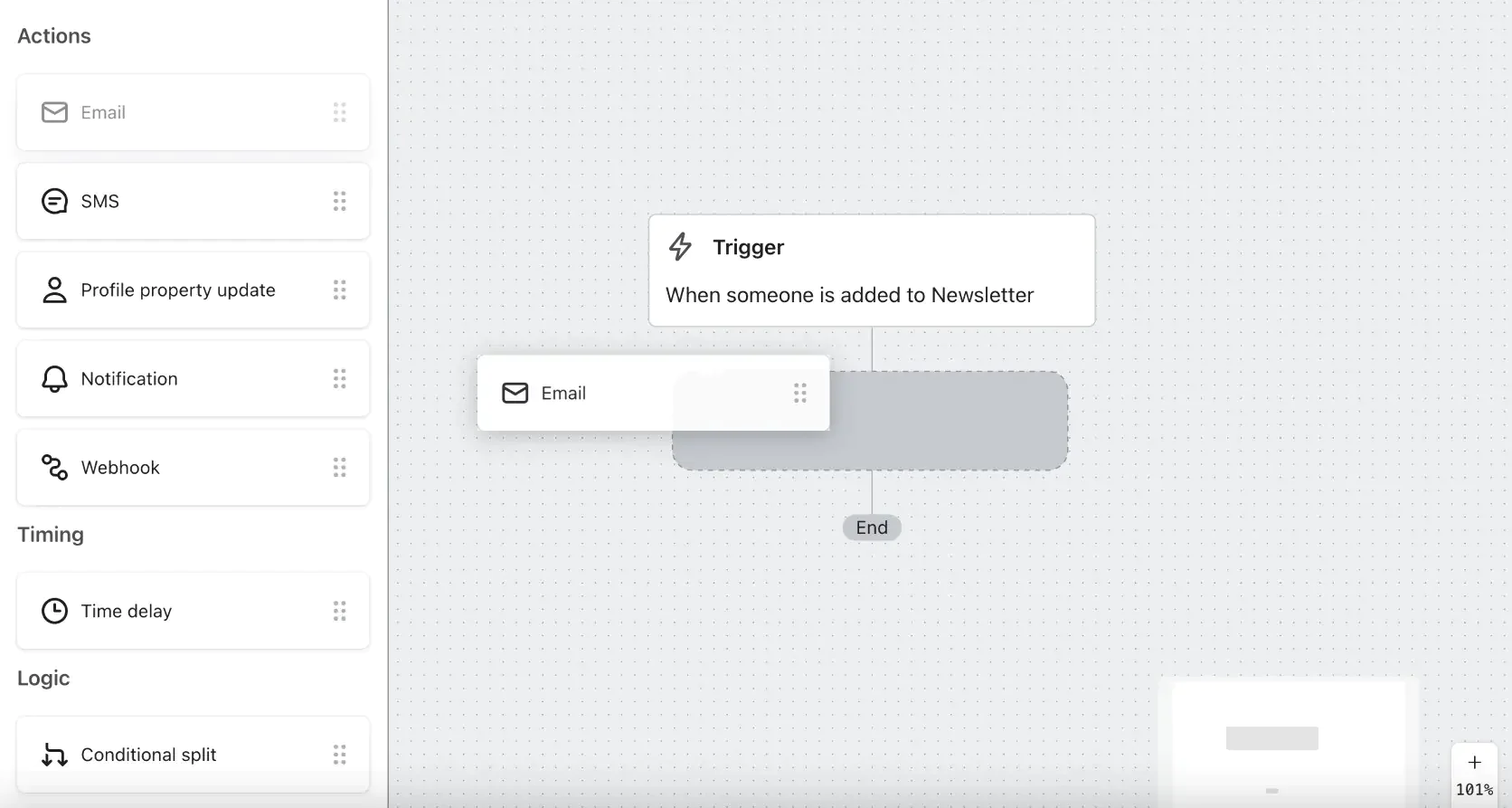
Klaviyo’s flow builder
Klaviyo focuses on deep email/SMS integration and also allows syncing segments to ad platforms (e.g., Facebook/Instagram, Google) as part of an omnichannel strategy. It excels in tying together email + SMS with e-commerce triggers, but lacks some channels (no built-in loyalty or WhatsApp).
Omnisend: ⭐⭐⭐⭐
True to its name, Omnisend offers a broader array of channels out-of-the-box. In addition to email and SMS, Omnisend provides native web push notifications (up to 500 pushes/month on the free plan). It formerly offered Facebook Messenger integration, though that was retired in favor of focusing on core channels.
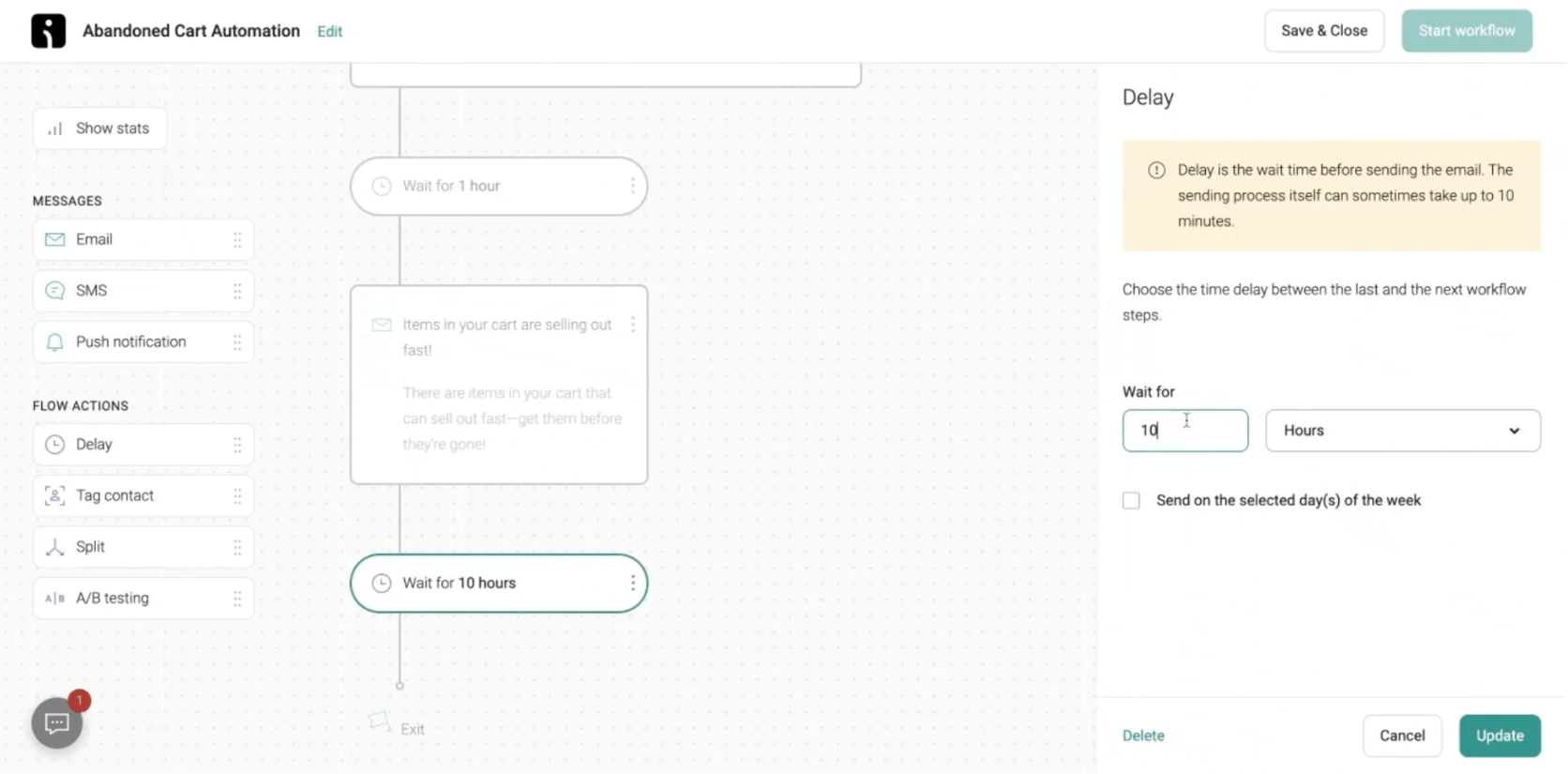
Omnisend’s flow builder
Omnisend’s automation workflows can include email, SMS, and push steps in a single unified sequence, ensuring a consistent message across channels. It also integrates with Facebook Custom Audiences and Google Customer Match to retarget or exclude customers in ad campaigns.
However, Omnisend does not have a built-in loyalty/rewards program or in-app mobile push (since most of its users don’t have custom mobile apps).
Maestra: ⭐⭐⭐⭐⭐
Maestra takes omnichannel a step further by uniting multiple communication and engagement channels in one platform. It includes email, SMS, web push, mobile push, and even a built-in loyalty and referral program. This means marketers can orchestrate not only messages but also reward actions from one flow builder.

Maestra’s flow builder
For example, Maestra’s omnichannel flows could send an email, follow up with an SMS, display a personalized web banner or pop-up, and even award loyalty points as a flow action—all based on real-time customer behavior. Maestra also supports in-session personalization on your website (e.g., showing different content or product recommendations to different segments as they browse).
Additionally, its integration of channels extends to offline: you can combine in-store purchase data with online behavior for true omnichannel segmentation. In short, Maestra is a centralized hub (with CDP capabilities) for omnichannel marketing, going beyond Klaviyo and Omnisend in channel integration (especially with loyalty and on-site personalization).
Omnichannel Flows Winner: Maestra
Klaviyo and Omnisend both enable multi-channel campaigns (email+SMS, etc.), but Omnisend natively supports more channels (adding web push) making it a more “omnichannel” solution than Klaviyo. Maestra stands out by incorporating not just messaging channels but also loyalty and on-site personalization into its automation, delivering a truly unified omnichannel experience.
For a marketer looking to consolidate as much as possible under one roof (including rewards programs and personalized web content), Maestra is compelling. Those focused on email/SMS primarily, with perhaps ad retargeting, might find Klaviyo or Omnisend sufficient.
Klaviyo vs Omnisend vs Maestra: Email Marketing
Email is the cornerstone of all three platforms. Each provides a visual email editor, templates, and automation for email campaigns and flows, but with some differences in sophistication:
Klaviyo: ⭐⭐⭐⭐⭐
Renowned for its powerful email marketing features, Klaviyo offers a drag-and-drop email composer with a rich library of templates. It supports dynamic personalization using customer data (e.g., inserting first name, product details, etc.) and even some predictive content, like recommended products. Klaviyo’s real strength is in triggered emails and segmentation—you can set up abandoned cart emails, browse abandonment, post-purchase follow-ups, and more, all finely targeted by user behavior and properties.
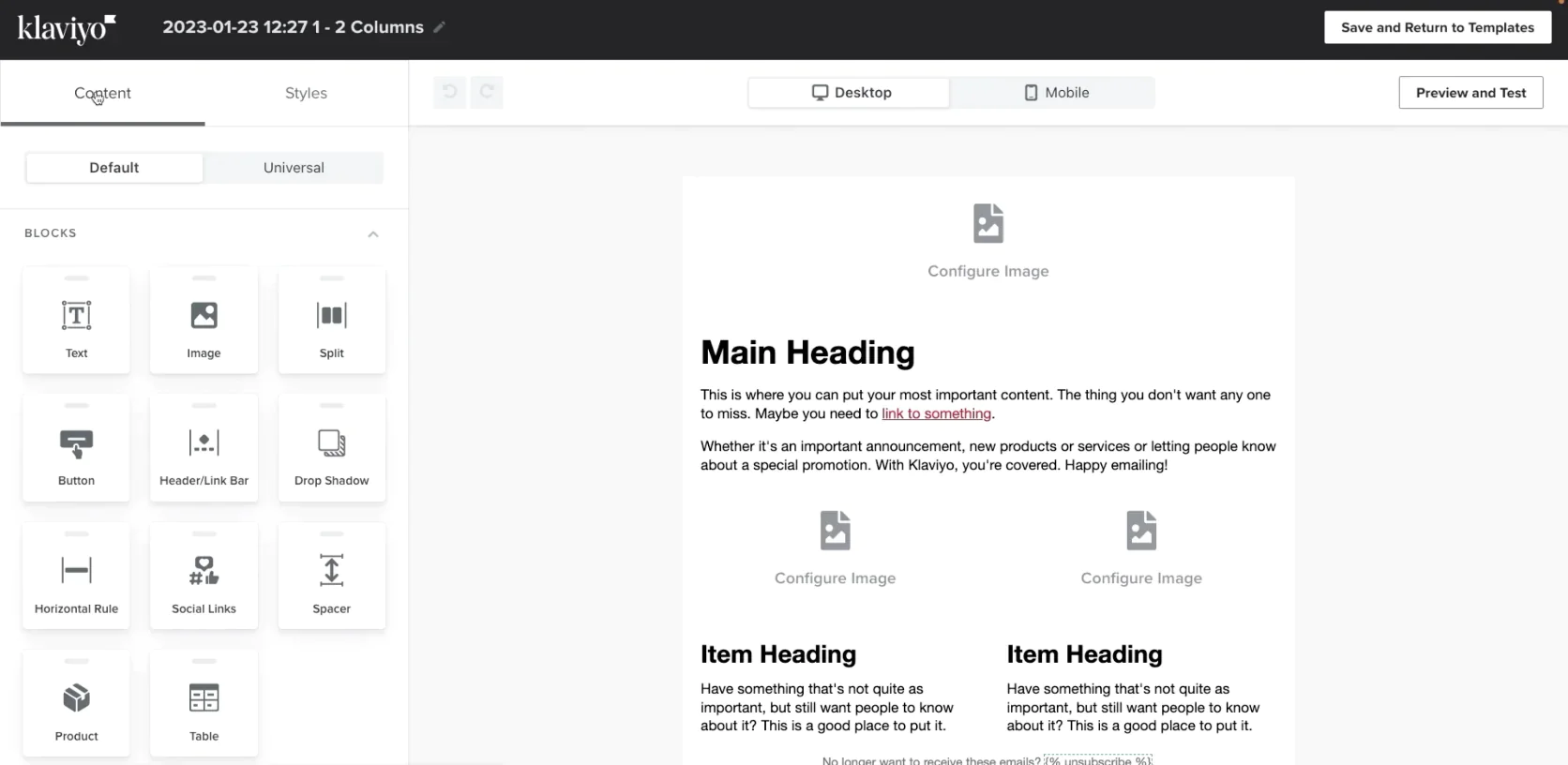
Klaviyo’s email composer
Klaviyo has also introduced predictive analytics (e.g., predicted lifetime value or churn risk) that you can use to tailor email content or send timing. Many marketers praise Klaviyo’s robust automation and deliverability as advanced features not commonly found in simpler tools. Klaviyo provides detailed email reporting—open rate, click rate, conversions, and attributed revenue—to refine campaigns.
Klaviyo’s email editor is powerful and generally efficient. EmailToolTester notes Klaviyo “offers more advanced features than Omnisend, such as predictive AI, powerful automations, and in-depth reporting, ” highlighting its strength in email marketing functionalities.
Omnisend: ⭐⭐⭐⭐
Omnisend’s email features are user-friendly and geared toward quick results. It provides various modern, mobile-responsive email templates, including seasonal and branded options. The editor is drag-and-drop and includes unique e-commerce content blocks like the “product picker” (to easily pull product images and details into emails) and scratch cards or gift boxes to make emails interactive.

Omnisend’s email templates
Omnisend emphasizes shoppable emails, allowing you to add product listings with buy buttons directly into newsletters. It supports basic personalization (names, coupon codes) and segmentation-based dynamic content. Automation covers all basics: welcome series, cart recovery emails, order confirmations, reactivation campaigns, etc., easily set up with pre-built flows.
While Omnisend might not have the predictive algorithms of Klaviyo, it covers 95% of typical email marketing needs straightforwardly. It’s often praised for being easy for beginners while offering solid functionality. All Omnisend features (including automation) are available even on the free plan, making it attractive for smaller stores starting out.
Unless you require very advanced personalization logic or analytics, Omnisend’s email toolset is sufficient, with the added perk of seamless integration with SMS and push in the same campaign.
Maestra: ⭐⭐⭐⭐⭐
Maestra’s email marketing is best-in-class for personalization. It offers a proprietary email composer built from the ground up, producing leaner code to avoid Gmail’s clipping limit. This means emails sent via Maestra can include rich dynamic content without risking Gmail clipping limits as quickly. Maestra’s editor supports dynamic content blocks that change per recipient in real-time.
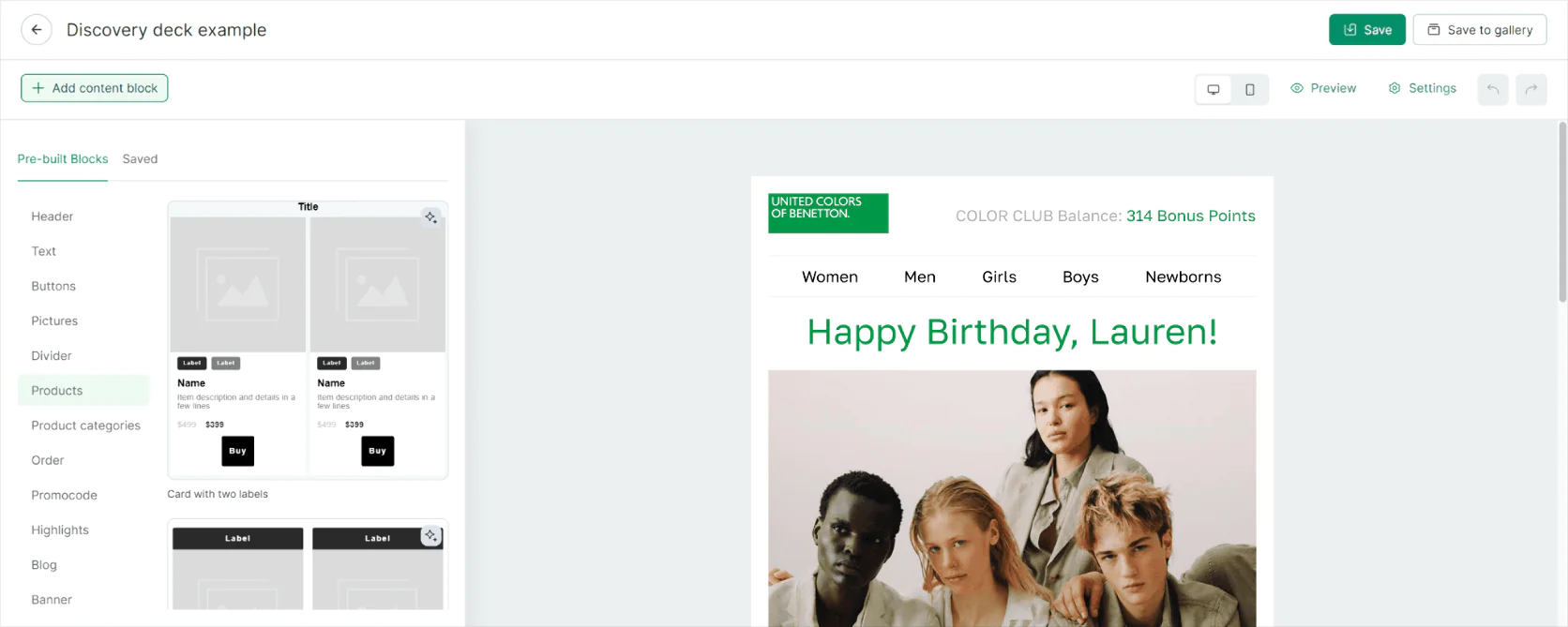
Maestra’s visual email composer
A single campaign can include a product showcase tailored automatically to each individual or segment—one customer might see personalized recommendations, while another sees a blog article, all handled dynamically within a single campaign.
Maestra also can auto-populate emails with external content, such as automatically generating a monthly blog digest email that pulls in your latest posts, significantly reducing manual curation efforts. The platform allows granular control over design (fonts, styles) and supports AMP for Email for real-time content updates.
Another standout feature is Maestra’s email health monitoring, benchmarking your email performance against industry standards (opens, spam rates, etc.) and alerting you if something’s off. This is valuable for maintaining deliverability. Maestra treats email as a highly personalized, automated channel where every message can feel uniquely one-to-one, aligning especially well with mid-market retailers looking to leverage rich customer data.
A significant advantage of Maestra’s email composer is its cleaner, leaner code, reducing email size by approximately 30% to avoid Gmail clipping, a frequent frustration with many platforms.
Email Marketing Winner: Maestra
All three platforms offer robust email marketing, but their focuses differ significantly:
- Omnisend excels in ease of use and eCommerce-specific features (shoppable content, ready-made templates) ideal for quick wins, especially for growing stores or beginners.
- Klaviyo offers more advanced approach with its predictive analytics.
- Maestra aims for best-in-class personalization and sophisticated automation at scale, ideal if you want each email highly tailored and leveraging a unified customer database.
Marketers with simpler needs may appreciate Omnisend’s user-friendly approach. Data-driven teams, however, will appreciate the advanced capabilities offered by Klaviyo and Maestra.
Klaviyo vs Omnisend vs Maestra: SMS Marketing
With consumers increasingly on mobile, SMS marketing has become a vital channel for eCommerce, often used for urgent alerts, promotional blasts, or complementing email campaigns. Klaviyo, Omnisend, and Maestra all include SMS capabilities, but with some nuances:
Klaviyo: ⭐⭐⭐⭐⭐
Klaviyo launched its integrated SMS in recent years, making it easy to add text messaging to your campaigns and flows. You can manage subscriber consent within Klaviyo’s forms and segment contacts by SMS vs email consent. In the flow builder, Klaviyo lets you create branches like “if user is SMS subscribed, send text; otherwise send email, ” which is great for orchestrating channel preference.
Klaviyo supports MMS (picture messaging) for the U.S. & Canada, allowing you to include product images or GIFs in texts. The SMS feature initially focused on North America (with dedicated toll-free or short code numbers), but Klaviyo has expanded support to the UK, Australia, and more regions over time—so it’s increasingly global, though check coverage if you have many international customers.
A big benefit is unified analytics: Klaviyo ties SMS sends to the same customer profile as emails, so you can see if a user clicked a link in a text and later purchased, contributing to attributed revenue.
Pricing for Klaviyo SMS is usage-based (you buy SMS credits or pay per message in addition to email plan). It’s not the cheapest, but it’s convenient. One limitation: Klaviyo doesn’t (yet) natively support other messaging apps like WhatsApp or Facebook Messenger—it’s strictly SMS/MMS in supported countries.
Omnisend: ⭐⭐⭐⭐⭐
Omnisend has built-in SMS that is available worldwide by using pooled sending numbers or giving you a number for major regions. Like Klaviyo, Omnisend’s automation workflows allow SMS steps alongside emails. They emphasize ready-made email + SMS automation templates—for example, the abandoned cart workflow can include an email, then an SMS reminder 1 hour later, etc., with minimal setup.
Omnisend supports MMS as well for US/Canada, so you can include images in campaigns. A highlight is that Omnisend includes some SMS credits even on free and low-tier plans (e.g., 60 SMS/month on free), giving small merchants a chance to try texting without extra cost. And like everything in Omnisend, SMS is managed in the same interface as email.
Another plus: Omnisend allows international SMS and will automatically handle compliance like including “Reply STOP to unsubscribe” where needed. It doesn’t support WhatsApp or other chat apps natively, focusing on traditional text messaging.
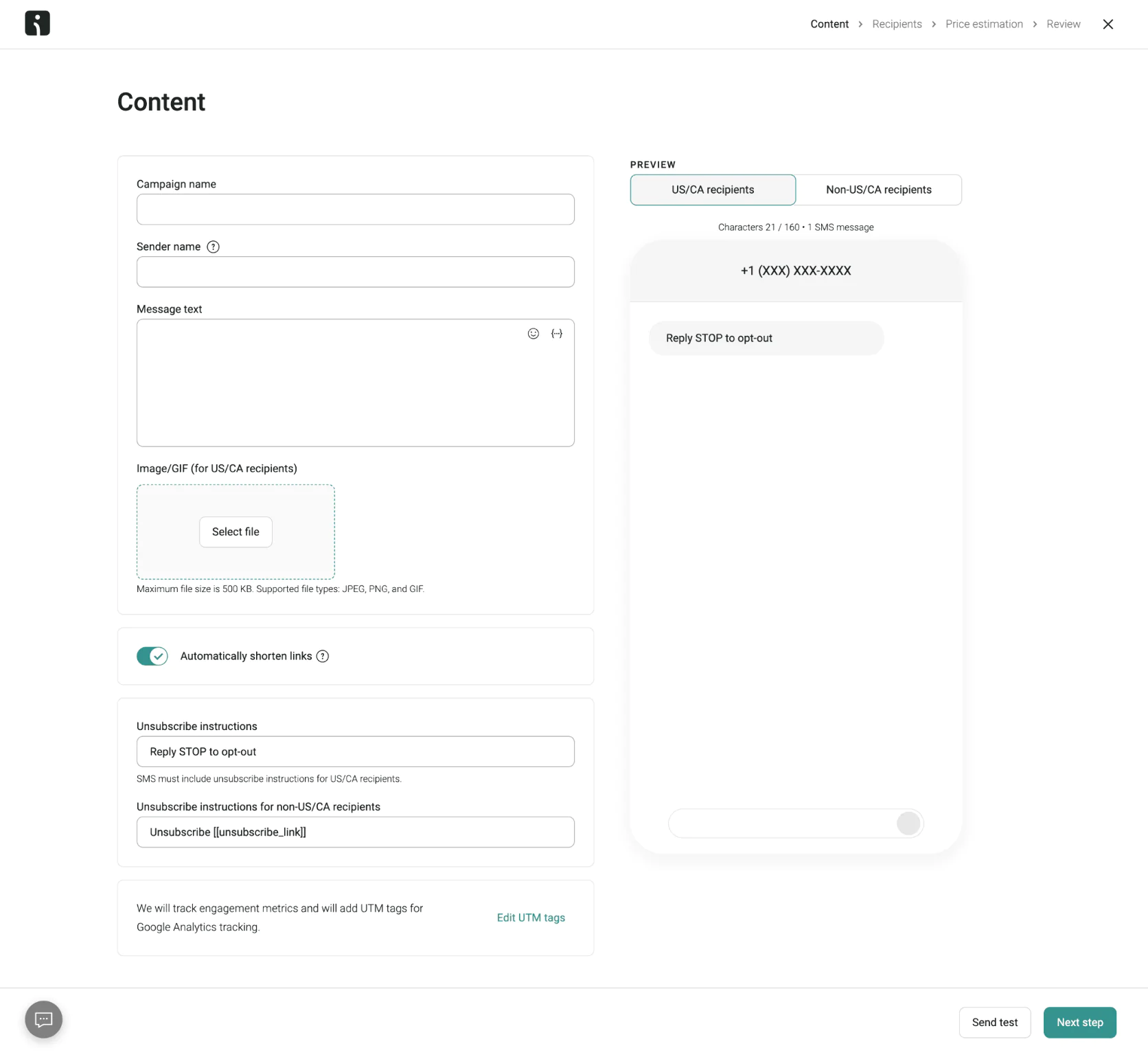
Omnisend’s SMS builder
For most eCommerce use cases (flash sales, order updates, back-in-stock alerts via text), Omnisend’s SMS does the job well. Users often appreciate that Omnisend’s SMS is seamlessly integrated—no need for a separate SMS provider or complicated setup. If you have a phone number field in your signup forms, that goes straight into Omnisend to use for text campaigns.
Maestra: ⭐⭐⭐⭐⭐
Maestra includes SMS as part of its omnichannel suite and integrates it tightly with its CDP and loyalty system. Functionally, Maestra’s SMS is similar—you can send campaigns or automated texts for things like order confirmations, shipping updates, or promotional offers.

Maestra’s SMS builder
One distinguishing factor: Maestra can leverage cross-channel logic with SMS. For example, after a purchase, you might configure Maestra to send an SMS offering bonus loyalty points for a review. This ties SMS into the loyalty/UGC strategy, beyond just marketing blasts.
Under the hood, Maestra partners with providers like Infobip for messaging infrastructure. Infobip is a global communication platform, which means Maestra’s SMS can reach customers worldwide.
Maestra can send WhatsApp messages as part of its offering. This is a capability neither Klaviyo nor Omnisend have natively. So if your brand could benefit from WhatsApp outreach—common in certain international markets—Maestra provides a path to do that under the same roof as your email/SMS campaigns.
Additionally, Maestra’s segmentation allows triggering SMS in real time based on customer behavior. For instance, if a VIP customer is on your site and their cart value hits a certain threshold, Maestra could instantly fire off an SMS with an exclusive offer, thanks to real-time segments and triggers. This immediacy can be powerful for conversions.
SMS Winner: Maestra
All three platforms treat SMS as an integral channel, not an afterthought. Klaviyo and Omnisend are quite comparable for SMS — both support MMS, both let you easily add SMS to workflows, and both cover global sending. Omnisend might be slightly more accessible for small budgets (with some free SMS quota).
Maestra matches these capabilities and extends them by integrating SMS with its loyalty and real-time personalization engine (plus WhatsApp support). If your focus is just straightforward promotional and transactional texting, Klaviyo or Omnisend will serve you well. But if you want to do clever things like texting loyalty point updates or leveraging WhatsApp, Maestra provides that edge.
Klaviyo vs Omnisend vs Maestra: Lead Generation (Signup Forms & Pop-ups)
Capturing new leads (emails/phone numbers) is a crucial part of growing an eCommerce audience. All three platforms offer lead generation tools like signup forms, pop-ups, and landing pages to convert website visitors into subscribers:
Klaviyo: ⭐⭐⭐⭐
Klaviyo includes a built-in Signup Forms feature that allows you to create pop-up modals, flyout banners, embedded forms, and full-page forms. These can collect emails and phone numbers (for SMS consent) and sync directly into your Klaviyo lists/segments. You can design forms with custom fields, choose triggers (e.g., show after 5 seconds, on exit-intent, etc.), and even target forms by URL or audience behavior.
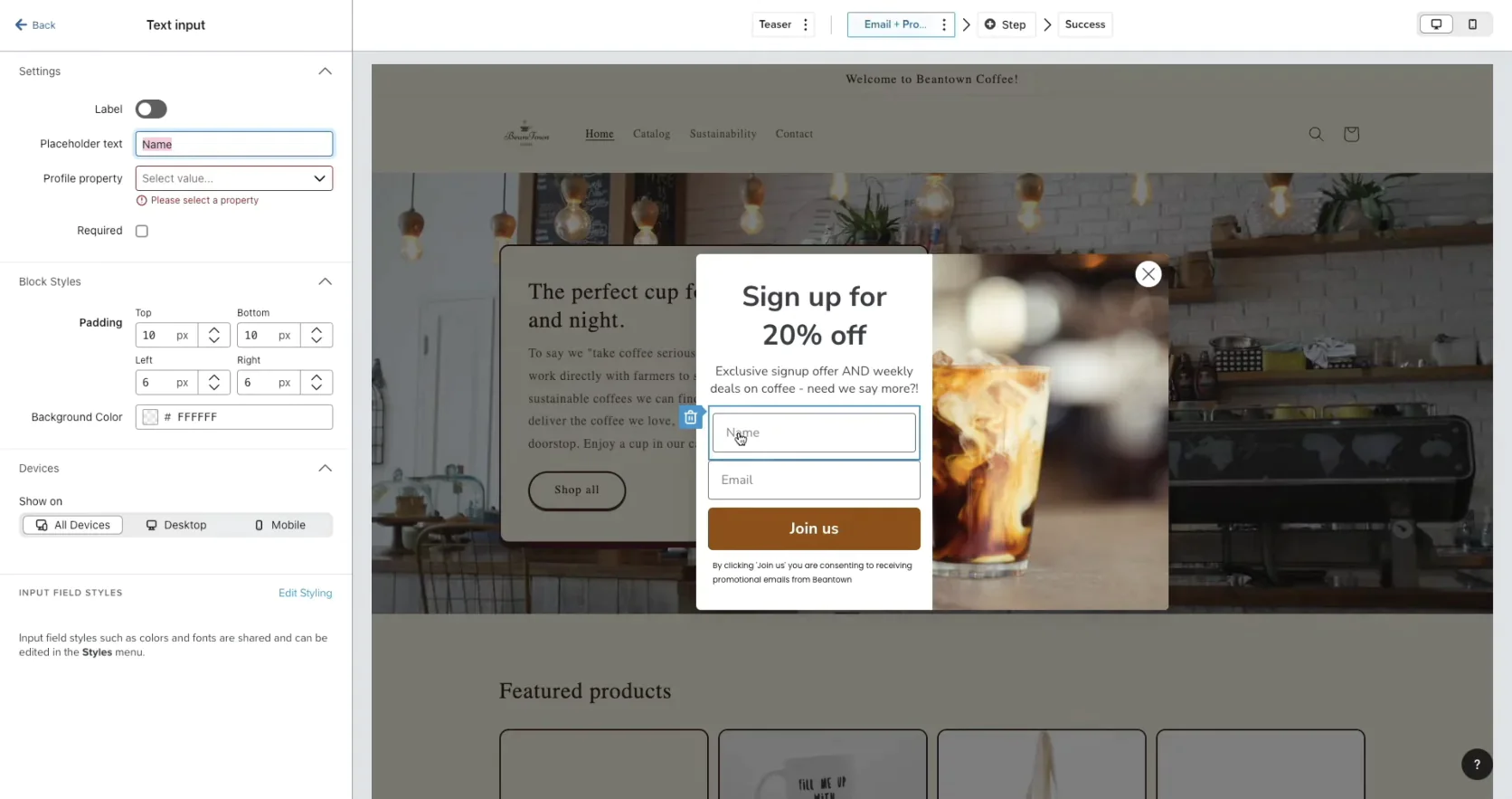
Klaviyo’s lead form builder
Klaviyo’s forms are fairly flexible in design, though not heavily template-driven—you start with a basic layout and customize it. One standout feature Klaviyo introduced is Forms Display Optimization, an AI-based tool that automatically tests different timing and trigger rules to find the highest-converting option for a form. This helps maximize signups by showing the form at just the right moment for each user (e.g., some users might see it after 10 seconds, some after scrolling halfway, etc., based on what the AI learns).
Klaviyo does not offer standalone landing page builders for campaigns (it focuses on on-site forms that overlay your site). But its forms cover most needs for capturing newsletter signups, exit offers, birthday club signups, etc. Klaviyo’s form analytics will report views, submissions, and conversion rate so you can gauge effectiveness. Overall, it equips marketers to capture leads without needing a separate tool like Privy or JustUno.
Omnisend: ⭐⭐⭐⭐⭐
Omnisend goes a step further by providing a variety of interactive form types. In addition to standard pop-ups, flyouts, and embedded forms, Omnisend offers a “Wheel of Fortune” gamified pop-up. The Wheel of Fortune is a spin-to-win game: visitors enter their email to spin a wheel for a chance at a prize (like a discount). This game form is popular for enticing signups through fun engagement, and Omnisend makes it easy to set up with pre-built designs.
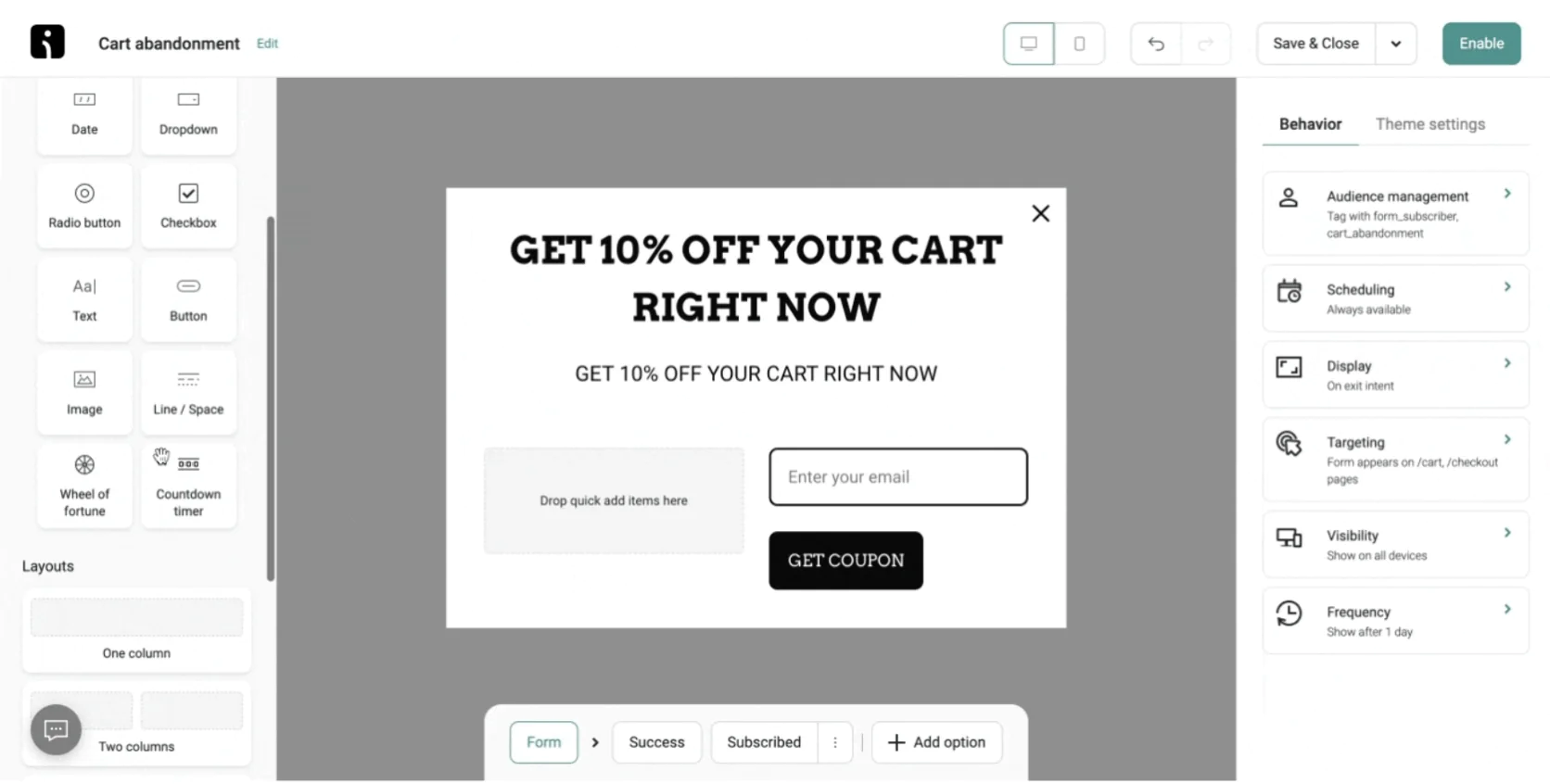
Popup form setup in Omnisend
Omnisend also supports other creative forms such as teaser tabs and full-screen overlays. Furthermore, Omnisend recently introduced the ability to collect product review ratings via forms on order confirmation pages (since they rolled out a reviews feature, they allow embedding a review request form, which is a kind of UGC lead capture—but that’s more UGC than lead gen).
For pure lead gen, Omnisend’s emphasis is on maximizing conversion: it has templates for holiday themes, the ability to A/B test form content, and targeting rules based on things like cart value or traffic source.
Notably, Omnisend also allows landing pages for signups. While not as robust as a dedicated landing page builder like Unbounce, you can create a simple subscribe landing page hosted by Omnisend (useful for link in bio or ad campaigns to capture email outside your website). And all contacts flow into Omnisend seamlessly.
A popular approach is using Omnisend’s Wheel of Fortune. Many Omnisend users praise this feature for significantly boosting signup rates compared to a normal pop-up.
Maestra: ⭐⭐⭐⭐⭐
Maestra’s platform also includes lead capture forms and pop-ups, integrated with its CDP and loyalty system. You can design pop-ups to collect emails/phones, or to promote a campaign. The key benefit with Maestra is you can incorporate loyalty incentives directly into sign-up forms. For instance, you can have a pop-up that says “Join our VIP club and get 100 points + 10% off your first purchase” or “500 bonus points if you purchase within 30 minutes”—since Maestra has loyalty, it can immediately reward those points on signup and display it.
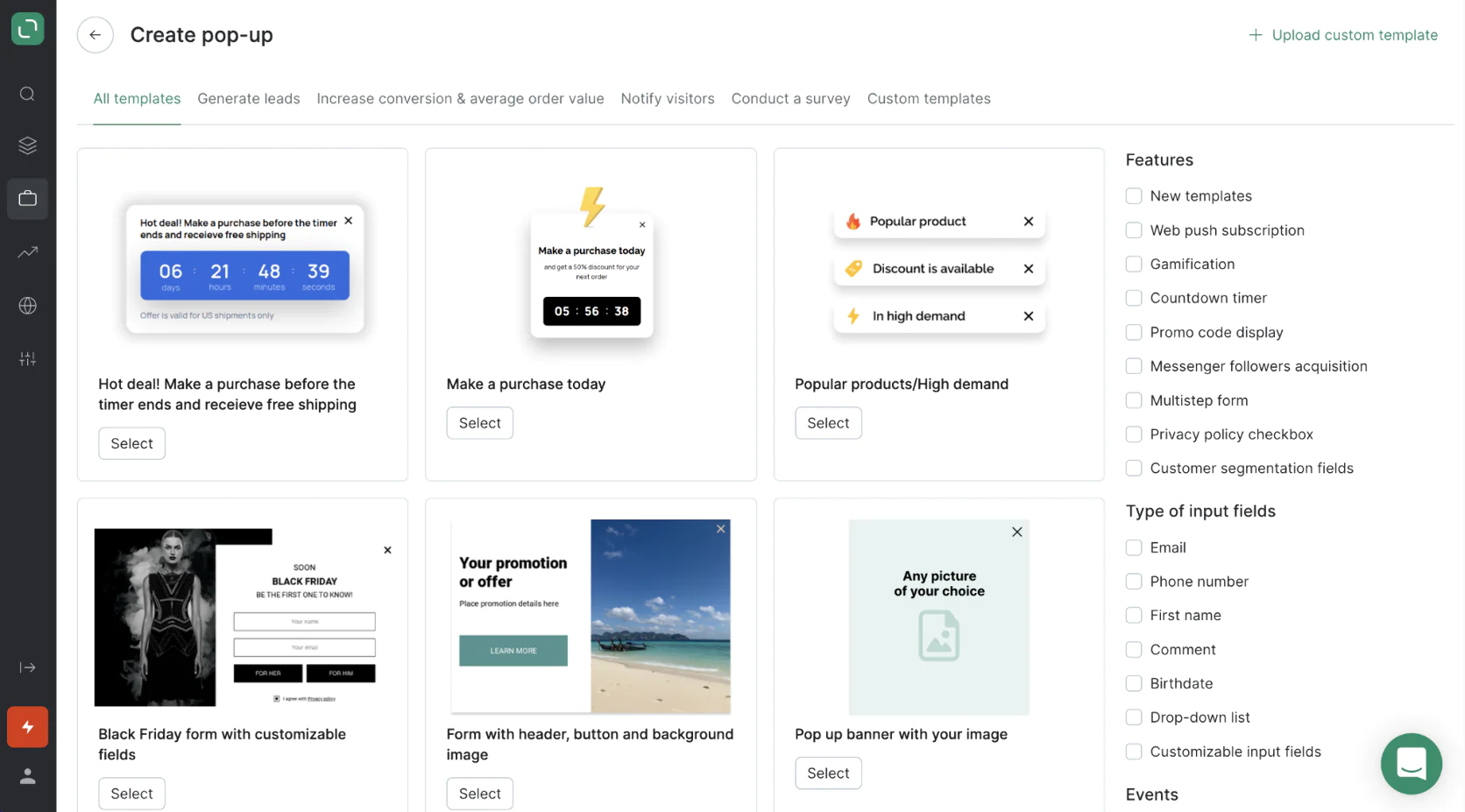
Maestra’s pop-up form templates
Additionally, Maestra can use its in-session segmentation to control form targeting. Because it knows a lot about the visitor in real time (if they’re a returning customer vs new, their browsing behavior, etc.), you could show highly personalized offers. For example, a form might dynamically mention a product category they were viewing or use their first name (if known from a cookie).
Maestra not only covers the fundamentals and makes them smarter through data—it supports gamified forms like Omnisend’s wheel. Also, any leads captured go straight into its single customer view (no need to integrate with another CRM).
Lead Generation (Signup Forms & Pop-ups)Winner: Maestra
For pure lead capture, Omnisend and Maestra stand out with creative, conversion-optimized forms (the Wheel of Fortune is a signature feature). Klaviyo provides solid form building with some AI optimization, which is great for continually improving opt-in rates without manual testing. Maestra offers integrated forms that tie into loyalty, allowing you to incentivize signups in novel ways (points, etc.) and personalize the experience deeply.
If your goal is to rapidly grow your list, Omnisend’s approach might yield faster results due to the gamified element. If you want to ensure that signups are immediately looped into a loyalty lifecycle, Maestra’s forms can give new subscribers a head-start in your rewards program. Klaviyo’s forms are dependable and already included for those who choose that platform, ensuring you don’t need a separate app.
Klaviyo vs Omnisend vs Maestra: Mobile and Web Push Notifications
Push notifications—whether they are app-based mobile push or browser-based web push—can be effective for real-time communication (flash sales, back-in-stock alerts, etc.) without relying on email or SMS. Here’s how each platform handles push:
Klaviyo: ⭐⭐⭐
Klaviyo supports mobile push notifications. For example, if you have a Shopify app or a custom mobile app, Klaviyo can send push notifications to users who installed the app and allowed notifications. This allows you to include mobile push as an action in Klaviyo flows (e.g., sending a push when someone adds to cart in-app but doesn’t check out).
However, Klaviyo does not support web push (browser notifications) as of now. There was a community feature request for browser push, and Klaviyo staff confirmed it’s not available yet.
For many small eCommerce businesses without a dedicated app, this means Klaviyo effectively has no push channel. Only those operating a mobile app can leverage it. If you do use it, Klaviyo’s push can be personalized and segmented like any other message. But again, it’s a narrower use case compared to web push which anyone can subscribe to via browser.
Omnisend: ⭐⭐⭐⭐
Omnisend provides web push notifications natively. Any visitor to your site can opt in with one click via their browser, and you can send them notifications even if they’re not currently on your site. Omnisend includes web push in its free plan (e.g., 500 pushes/month free), signifying it’s a core channel.
Setting up web push in Omnisend is straightforward: you add a snippet to your site and design the opt-in prompt. Once subscribed, you can send campaigns or automated pushes (e.g., an abandoned cart push 15 minutes after they leave).
Omnisend even offers automation templates for push and guidance on combining push with other channels for an omnichannel effect.
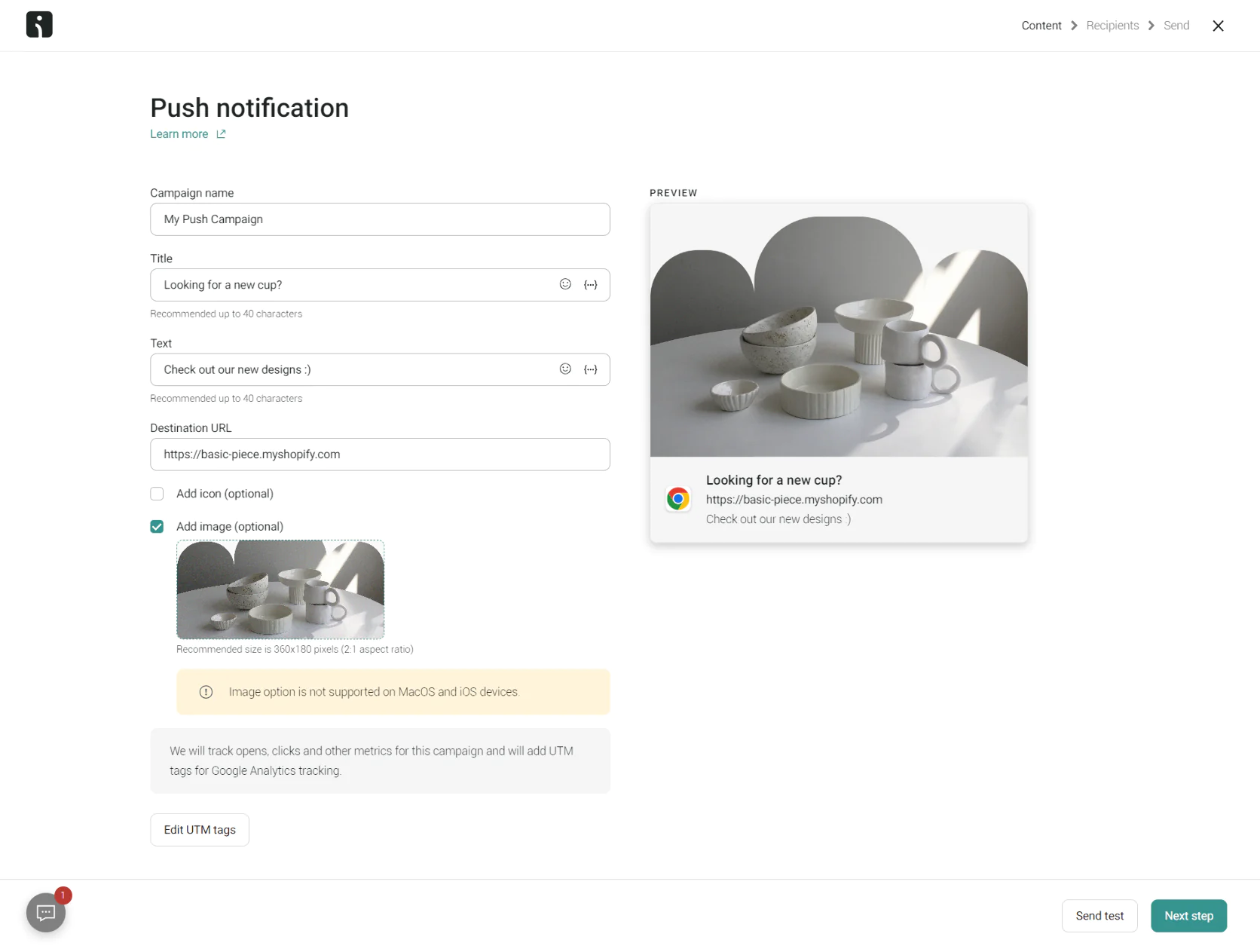
Push notifications campaign in Omnisend
For example, you might send a web push immediately when a cart is abandoned, then an email 30 minutes later, then an SMS a few hours after—increasing chances to re-engage.
Omnisend does not have mobile app push (no SDK for your app). If you needed that, you’d do it outside Omnisend. But for most, web push is more universally applicable. Also, Omnisend’s push notifications can include an image, title, message, and link, similar to typical browser pushes. They can be highly effective for short, urgent messages like “Hey, you left something in your cart!” or “50% off sale ends tonight—click here.”
Maestra: ⭐⭐⭐⭐⭐
Maestra supports both web and mobile push notifications as part of its omnichannel arsenal. For web push, it offers similar functionality to Omnisend — enabling visitors to subscribe and then sending pushes via browser. For mobile push, Maestra provides an SDK to send push messages to a brand’s mobile app users.
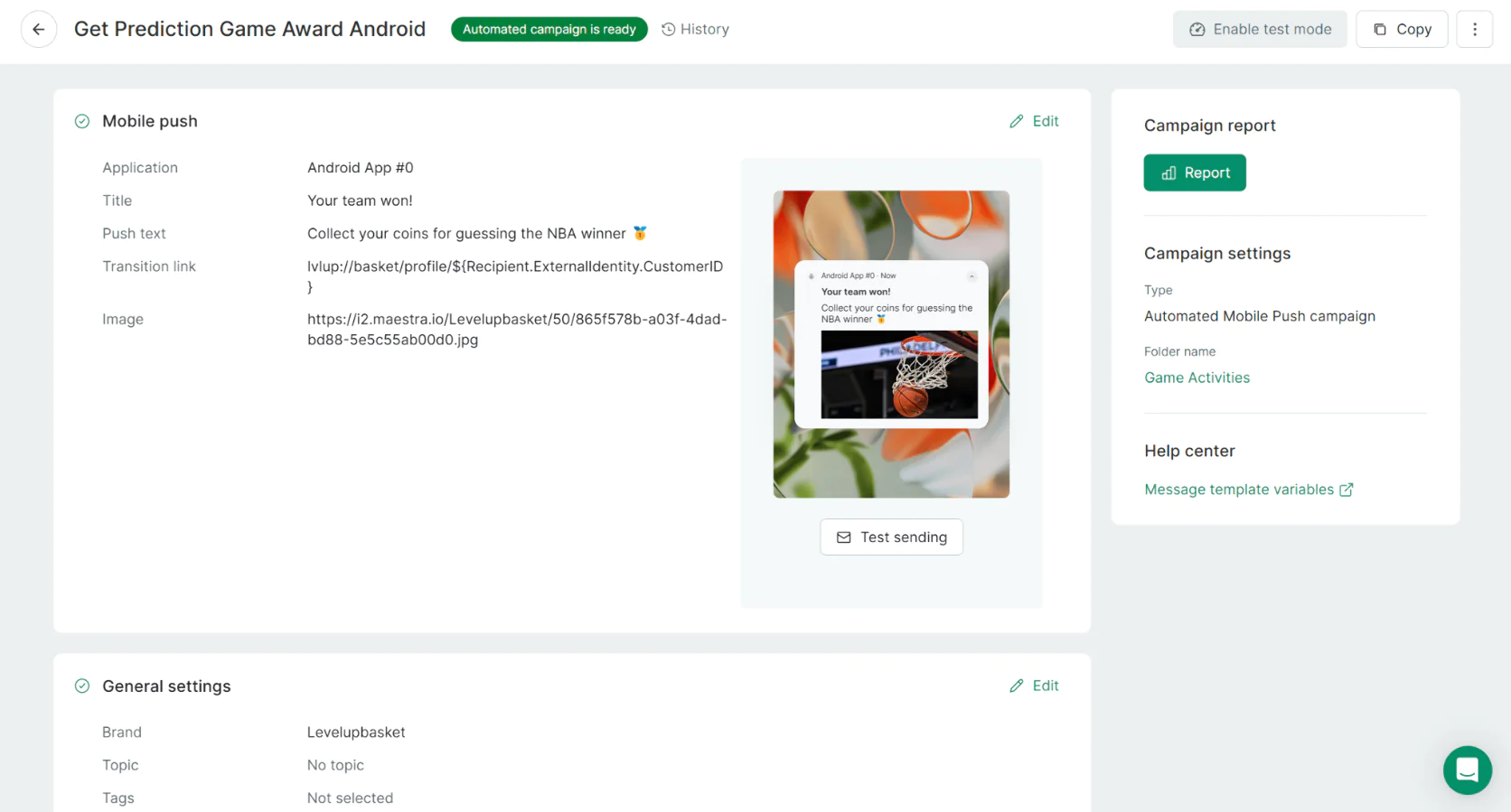
Maestra’s mobile push builder
Maestra not only sends push, but can personalize them with user data and even trigger them in-session.
More straightforward, Maestra can ensure push messages are synchronized with other channels: e.g., send a push, an email, and an SMS all as part of a coordinated campaign, with logic to avoid over-messaging a user who converts on one of those channels.
Also, since Maestra has built-in promo codes and such, you could send a push that contains, say, a unique one-time discount code as a reward for certain actions.
Mobile and Web Push Notifications Winner: Maestra
Omnisend makes web push accessible to all. Klaviyo only handles mobile push for those with apps. Maestra covers both types of push, aligning with its all-in-one philosophy.
Klaviyo vs Omnisend vs Maestra: Customer Data Management (CDP)
Effective marketing relies on customer data—purchase history, behaviors, preferences. A Customer Data Platform (CDP) centralizes and processes this data. Let’s compare how each platform handles customer data management:
Klaviyo: ⭐⭐⭐⭐
Klaviyo operates as a mini-CDP tailored for eCommerce. When integrated with your store (Shopify, Magento, etc.), Klaviyo automatically ingests a wealth of data: order history, product details, customer profile properties, website behaviors (via Klaviyo’s tracking snippet for viewed product, added to cart, etc.), and even custom events from other tools. All this data is tied to individual customer profiles in Klaviyo.
You can then create segments or triggers using virtually any combination of these data points (e.g., “Customers who viewed Product X but haven’t purchased, and have lifetime spend > $100”).
Klaviyo’s data schema is quite flexible—you can add custom properties to profiles (like birthday, gender, loyalty tier from an external program, etc.) and use them in campaigns. It also stores event data (each opened email, each site visit, each placed order) up to a limit, allowing segment conditions like “Number of orders = 0” or “Last active date > 30 days ago.” In that sense, Klaviyo is a marketing database.
Many marketers find that Klaviyo becomes their single source of truth for customer contact info and key engagement metrics, especially if they don’t have a separate CRM.
However, Klaviyo is not a full-fledged enterprise CDP—it’s optimized for the data coming from eCommerce contexts and its own forms. Real-time updating is good (e.g., if someone makes a purchase, their profile is updated and can trigger flows within minutes), but it’s not always instantaneous in on-site scenarios (there can be slight delay in syncing events from site to Klaviyo, though usually negligible).
Klaviyo recently has been positioning itself closer to a CDP with features like user-defined custom metrics and integrations beyond eCommerce (they have APIs to accept data from anywhere). So, it’s quite powerful for customer data management at the SMB/mid-market level.
Omnisend: ⭐⭐⭐
Omnisend also aggregates customer data but is somewhat more limited to marketing-centric info. It will sync basic customer info and order data from your store (e.g., via Shopify integration it pulls order history, product names, etc.). You can track website events (viewed page, cart events) with Omnisend’s JavaScript as well.
So on the surface, Omnisend profiles might look similar to Klaviyo’s—showing contact info, tags, campaign history, and browsing history if enabled.
One area Omnisend isn’t as deep is custom properties and analytics on them. It has segmentation, but not as many layers as Klaviyo. For example, Klaviyo has predictive scores (like likelihood to churn), whereas Omnisend does not.
Omnisend’s segmentation UI is straightforward for typical recency-frequency-monetary (RFM) type filters (e.g., last order date, total spend, campaign engagement, etc.). It does allow custom events via API, but fewer Omnisend users utilize it compared to Klaviyo’s user base.
Omnisend doesn’t brand itself as a CDP—it’s more of a marketing automation database. It also might not handle extremely large volumes or real-time streams as gracefully as a dedicated CDP (for instance, if you wanted to pipe in live inventory updates or offline purchase data, that’s outside Omnisend’s normal use).
That said, for most eCommerce marketing needs, Omnisend’s customer data management is sufficient. You see each contact’s omnichannel engagement in one place and you can segment based on what you see.
Maestra: ⭐⭐⭐⭐⭐
Maestra was designed from the ground up as a real-time CDP (Customer Data Platform) for midsize retail. This is one of its core value propositions. It unifies data from online stores, physical stores (POS systems), websites, mobile apps, and more into a single view for each customer.
The data engine works in real time, meaning if a customer makes an in-store purchase, Maestra can update their profile immediately and adjust any active segments or triggers. If they browse online, that behavior is captured and usable during the same session for personalization.
Maestra’s CDP can store a wide array of attributes: demographics, purchase history, browsing events, loyalty points, referral invites, and even derived metrics. They offer computed fields—custom attributes that get calculated on the fly (like “number of categories purchased from” or “most frequent product type”), which you can use for segmentation.
Moreover, Maestra’s strengths are data quality and integration—it’s open API and data import/export tools allow you to pull in data from external sources (ERP, customer support software, etc.) to enrich profiles. For example, a retailer could feed in offline CRM notes or e-receipt data into Maestra.
Having this unified data is what powers Maestra’s advanced segmentation and personalization. For instance, Maestra can do in-session segmentation—meaning as soon as a user clicks around, it can classify them (new vs returning customer, interested in Category X, etc.) and adapt marketing accordingly (like show a personalized homepage banner).
In essence, Maestra positions itself not just as an email/SMS tool but as the central customer database for marketing. This is akin to enterprise solutions (Exponea/Bloomreach, Emarsys, etc.), but aimed at mid-market businesses who want real-time responsiveness without needing a separate CDP product.
Customer Data Management Winner: Maestra
If robust customer data management is critical—say you want a 360° customer view and lightning-fast segmentation—Maestra is designed for that.
Klaviyo also handles rich data and is often sufficient for data-driven eCommerce marketing, but it might not unify offline data as seamlessly or do truly real-time updates within a live session.
Omnisend manages the basics of customer data but is less of a “data platform” and more of a marketing tool.
For many small businesses, Klaviyo/Omnisend’s data capabilities are enough. But as data sources multiply (website, mobile app, retail store, loyalty program), Maestra’s ability to consolidate and act on data in real time becomes a strong advantage.
Klaviyo vs Omnisend vs Maestra: User Segmentation
Effective segmentation allows sending the right message to the right people. All three platforms offer segmentation, but let’s see how they compare in granularity and ease:
Klaviyo: ⭐⭐⭐⭐
Klaviyo is known for very powerful segment building. Marketers can create both static lists (manual or via imports) and dynamic segments based on a wide range of conditions. You can mix demographic data (properties) and behavioral events in the logic.
For example, a segment could be defined as “Has placed an order in the last 90 days AND Lifetime spend > $500 AND Is not in VIP Tier”—Klaviyo will automatically include all profiles that meet those criteria and update the segment as people’s data changes. Segments update in near real-time (usually within minutes of a profile meeting the condition).

Klaviyo’s segment builder
Klaviyo also supports relative date filters (e.g., last X days/weeks) and has OR/AND grouping for complex logic. One limitation historically was that Klaviyo segments were not nested (you couldn’t use one segment as a condition inside another easily), but you could generally recreate that logic directly. They have since added ability to exclude or include other segment members as part of conditions, which helps.
Additionally, Klaviyo introduced some predictive segments leveraging ML—for example, you can segment by “Predicted Gender = Male” or “Expected next order date within next 30 days” for more forward-looking targeting (this uses Klaviyo’s predictive analytics from data). That’s relatively advanced and not something Omnisend offers natively.
Overall, Klaviyo’s segmentation is one of its strongest suits. It’s flexible and fairly user-friendly, given the depth (the UI presents dropdowns to choose metrics, events, timeframe, etc.).
Omnisend: ⭐⭐⭐
Omnisend’s segmentation capabilities cover the most common needs but are a bit more limited in complexity. You can segment by:
- Profile data (location, signup source, etc.)
- Campaign engagement (opened email, clicked SMS, etc.)
- Purchase behavior (number of orders, total spent, last order date, products purchased)
- Website activity (if tracking is enabled: viewed product, added to cart, etc.)
- And even custom events if you pass them.
Omnisend’s interface allows combining conditions with AND/OR logic, similar in concept to Klaviyo, but it may not allow as many nested or multi-layer conditions. It tends to encourage simpler segments like “VIP Customers—placed >3 orders OR spent > $500” or “Engaged Non-Buyers—opened last 5 campaigns but 0 orders.”
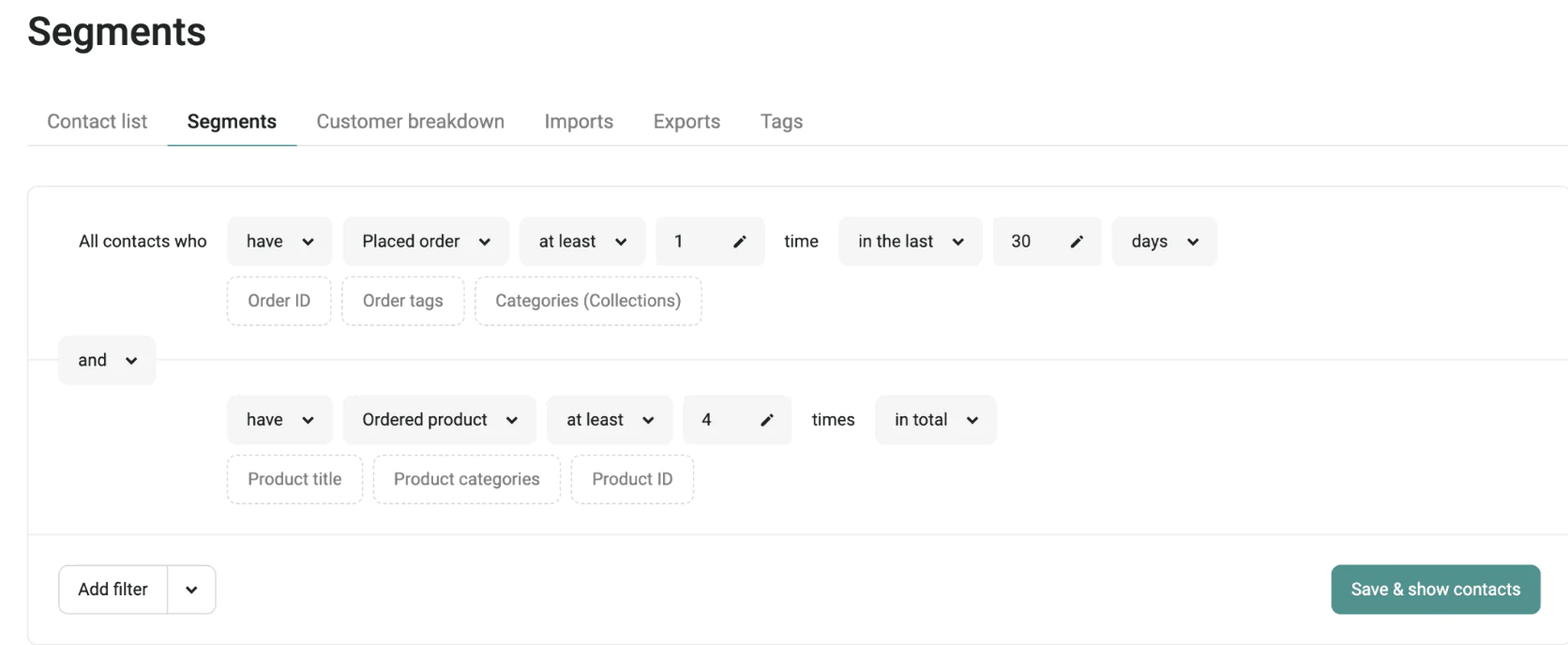
Omnisend’s segment builder
One difference: Klaviyo segments are dynamic and used for both targeting and triggering flows, whereas Omnisend historically relied more on automation triggers (like “if user has this behavior, send flow”) and segments primarily for campaign sends or exclusions. However, Omnisend does have a segmentation engine and you can save segments that auto-update.
The real-time aspect: Omnisend might not update segments in the middle of a user’s browsing session, but it will update fairly quickly as data comes in (especially for triggered automations, it checks conditions live). For campaign sends, you usually compute the segment at send time.
In sum, Omnisend segmentation is strong for its target market (SMBs)—you can do RFM segmentation, engaged vs unengaged subscribers, etc., with ease. But if you want ultra-granular or computed metrics, it may not have everything.
Maestra: ⭐⭐⭐⭐⭐
Segmentation is a cornerstone of Maestra. It offers real-time, nested segmentation with computed fields. Let’s break that down:
- Real-time: Segments update instantly as data streams in. If a user crosses a threshold or performs an event, Maestra knows immediately and can include/exclude them from segments right away. This is crucial for things like in-session personalization or sending “back in stock” alerts exactly when someone who wanted that product comes online.
- Nested: You can create segments based on other segments or combine segments logically. For example, you might have a broad segment “VIP Customers” and another “At-Risk Customers” and then intersect them in a nested fashion (“VIPs who are At-Risk”). Or build a segment like “High-Spenders interested in Category X” by nesting “High-Spenders” segment within a category interest filter. This kind of multi-layer segmentation is powerful for complex lifecycle marketing.
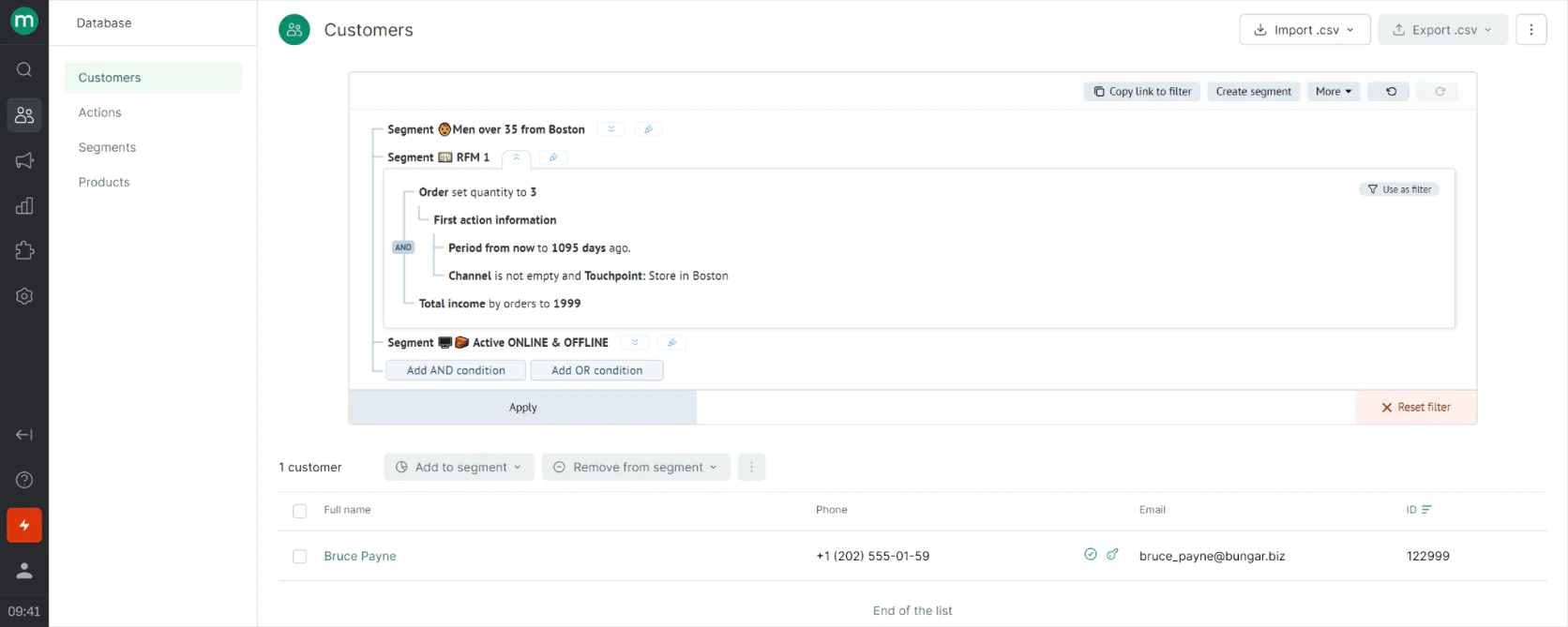
Maestra: user segmentation
- Computed fields: Maestra can calculate custom fields per profile (like a running metric). For instance, “Average purchase interval (days)” or “Favorite category = [the category from which they purchased most often]”. These fields update continuously and can be used for segmentation like any other property. That’s an enterprise-grade feature; it lets you target behaviors that aren’t directly stored but derived from behavior patterns.
Maestra’s segmentation UI likely allows very fine-grained filters, combining on-site behavior (even current session behavior), transaction history, loyalty status, and more in one segment definition. You can target customers who bought during a flash sale but abandoned another item in cart—something requiring multi-condition and event sequence logic, which Maestra can handle elegantly.
With such capabilities, Maestra empowers highly precise targeting, which can boost campaign relevance significantly (leading to better conversion rates).
Segmentation Winner: Maestra
Maestra offers the most advanced segmentation capabilities (suitable for power users and complex strategies), followed by Klaviyo which is very strong for most eCommerce segmentation needs short of real-time on-site adjustments.
Omnisend has solid basic segmentation but is a bit more simplified, focusing on practical filters for eCommerce rather than heavy customization.
Your choice might depend on how much you plan to slice and dice your customer base and whether you need those segments to update in the blink of an eye. If you require instant segmentation and highly specific combinations of criteria, Maestra is built for that level of detail.
Klaviyo vs Omnisend vs Maestra: Website and Email Product Recommendations
Personalized product recommendations can increase conversion by showcasing items the customer is likely to buy. Let’s see how each platform helps implement recommendations in emails and on websites:
Klaviyo: ⭐⭐⭐
In email, Klaviyo provides a built-in Product Recommendation block that you can insert into emails. This block can be configured to show items based on certain logic: popular items, new arrivals, or personalized picks for each recipient. Klaviyo’s personalized recommendation algorithm considers a customer’s past browsing and purchase behavior to suggest products they haven’t bought yet.
For example, it might show complementary items to their last purchase or trending products in categories they’ve shown interest in. This is fairly plug-and-play – you drag the block into your email template and Klaviyo fills it with products when sending, tailored to each recipient.
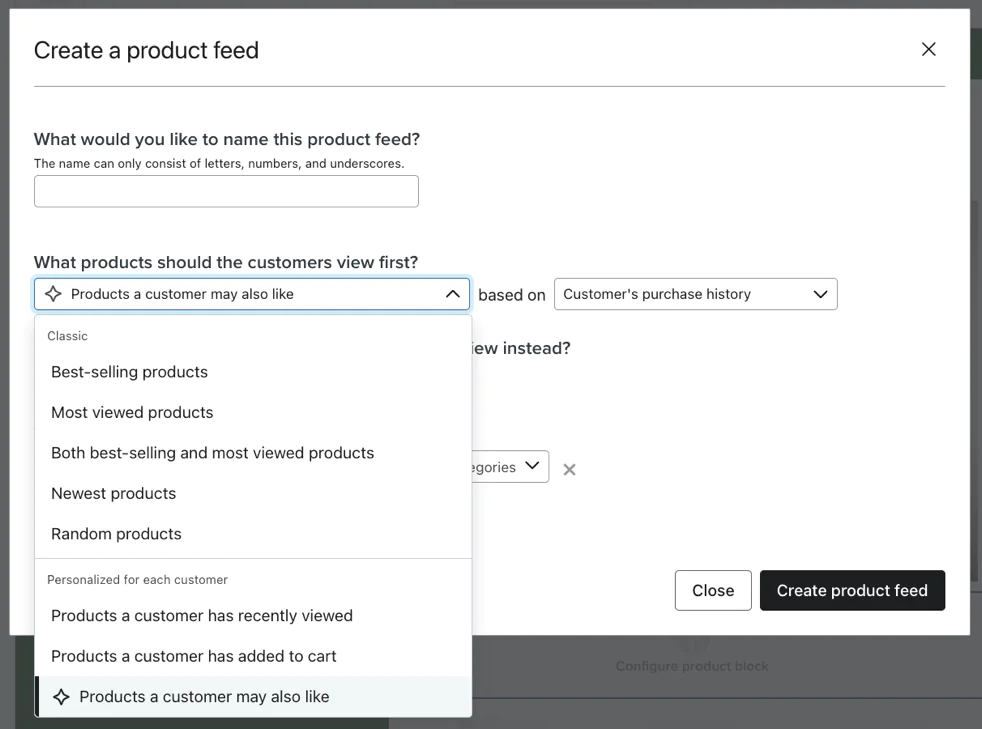
Creating a product feed for personal recommendation in Klaviyo
The recommendations can be limited to certain collections or categories if you want. While not as sophisticated as say Amazon’s algorithm, it does a decent job and many merchants use Klaviyo’s recommendation block to populate “You might also like” sections in newsletters or flow emails (like post-purchase upsells).
On the website side, Klaviyo does not have an out-of-the-box widget for product recommendations. It tracks browsing, but it doesn’t provide a front-end component to display “Recommended for you” on your site—that’s the realm of onsite personalization tools or your eCommerce platform’s functionality. You could theoretically export Klaviyo data to use elsewhere, but practically, if you need on-site product recs, you’d use a dedicated personalization app.
Omnisend: ⭐⭐⭐
For emails, Omnisend similarly offers a Product Recommender content block. Omnisend’s product recommender can automatically pull in products from your store to include in an email. You can set it to show best-sellers, newest products, or even dynamic personalized picks.
By default, one common use is to include a row of “Popular products” in a newsletter without manually selecting them—Omnisend will fetch the top sellers or items back in stock, etc.
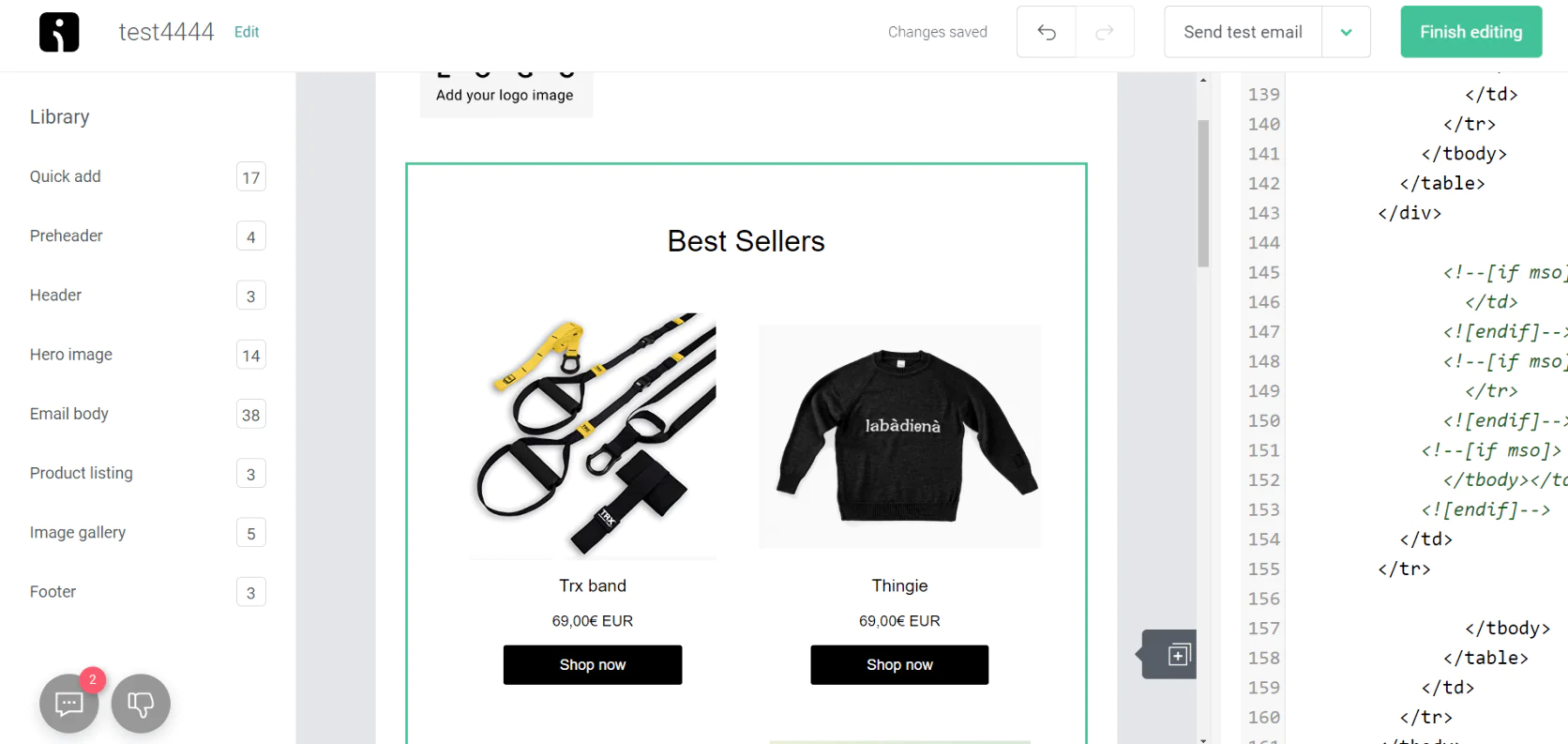
Omnisend: creating a personalized recommendations block
For more advanced needs, Omnisend integrates with a specialized AI recommendation service (Argoid) showing that for truly AI-driven recs, they partner. But most small brands get by with the basic logic (newest, trending, or related to last purchase).
Omnisend also has a feature to recommend items based on the customer’s last viewed products via automation emails (like a browse abandonment email can include the product they viewed plus similar items).
On the site, Omnisend does not offer on-site product recommendation widgets. It focuses on communications, not altering the storefront. If you wanted to use those recommendations on site, you’d need to use the integration (like Argoid or another app).
Maestra: ⭐⭐⭐⭐⭐
Because Maestra’s CDP knows customer preferences and real-time context, it can generate highly relevant recommendations.
In emails, Maestra can do everything Klaviyo/Omnisend do—insert dynamic product recommendations blocks personalized to each customer. But Maestra can go further by using complex triggers, for example:
- If a product’s price drops and a customer had shown interest (browsed or wishlisted it), Maestra can notify them with that specific product.
- If stock of a product is low and a customer had it in their cart previously, Maestra can send a tailored recommendation “Your favorite item is almost sold out!”.
These are hyper-personalized recommendations leveraging real-time product event triggers (price change, low stock) combined with individual customer behavior—a level of precision beyond generic “you might like these popular items”.
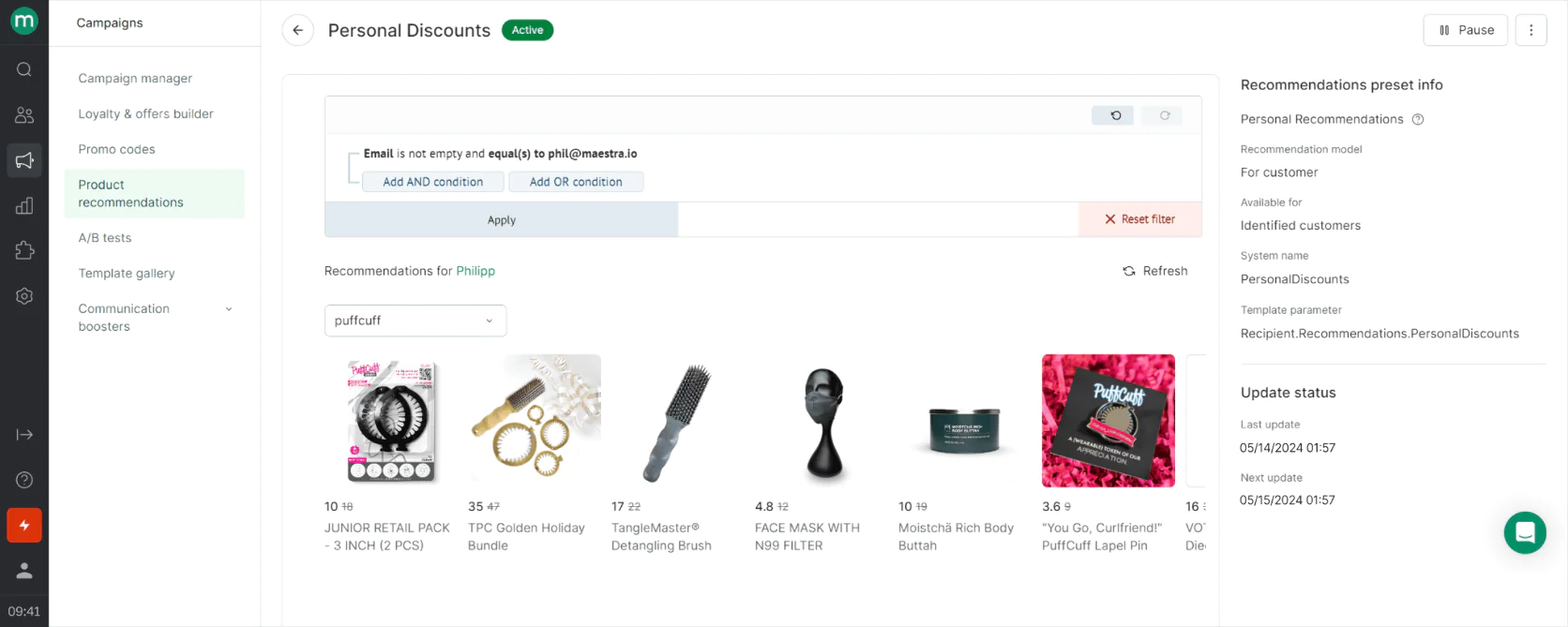
Maestra: creating a personalized recommendations block
For on-site recommendations: Maestra can affect what products are shown to whom. If Maestra is integrated with your site, it can highlight certain items for a customer segment. Maestra uses its CDP and AI to analyze customer data including browsing history, purchase patterns, and trending items to deliver personalized product recommendations. These power website sections like "Recommended for you" with individualized content.
Recommendations update in real-time based on recent browsing activity, potentially changing your homepage content overnight.
Maestra operates across all channels ensuring recommendations are consistently intelligent and complementary across every touchpoint.
Product Recommendations Winner: Maestra
For email product recommendations, all three can automatically populate product suggestions, with Maestra and Klaviyo being more data-driven/personalized by default and Omnisend offering straightforward recommender options.
For on-site recommendations, Maestra is the only one of the three that directly focuses on on-site personalization. Klaviyo and Omnisend users typically rely on other apps for on-site recs.
Klaviyo vs Omnisend vs Maestra: Loyalty and Rewards Features
One of the biggest differentiators in this comparison is loyalty program functionality. Many eCommerce brands use separate loyalty and referral platforms (like Smile.io, Yotpo Loyalty, LoyaltyLion, etc.) alongside their email tools. Here’s how the three platforms compare:
Klaviyo: ⭐
Klaviyo does not include a native loyalty or rewards program. It focuses on communications, and for loyalty, it relies on integrations. For example, Klaviyo integrates with loyalty apps like Smile.io, Swell (Yotpo Loyalty), or LoyaltyLion to sync data such as point balances or VIP tier, which you can then use in segments or include in emails.
Essentially, Klaviyo provides the messaging for loyalty (e.g., sending an email when someone earns points, if the loyalty app triggers it), but the heavy lifting is done by third-party tools.
Omnisend: ⭐
Like Klaviyo, Omnisend does not have a built-in loyalty/rewards module. Its focus is on messaging automation. You would integrate a loyalty platform (there are integrations for loyalty apps on Omnisend’s App Market) and possibly connect it via Omnisend’s API or use customer tags to indicate loyalty status.
Maestra: ⭐⭐⭐⭐⭐
This is where Maestra differentiates itself strongly. Maestra includes a fully integrated loyalty and rewards program as a core component. You can configure point earning rules, rewards (discounts, free products, etc.), VIP tiers, and referral programs within Maestra. Because it’s under one roof, the loyalty system works hand-in-hand with Maestra’s messaging and segmentation.
For example, when a customer performs an action on your site, Maestra can immediately reward points and then send a personalized email or pop-up showing the updated points balance. Customers can be shown their loyalty status in real time, whether on the website or in an email.
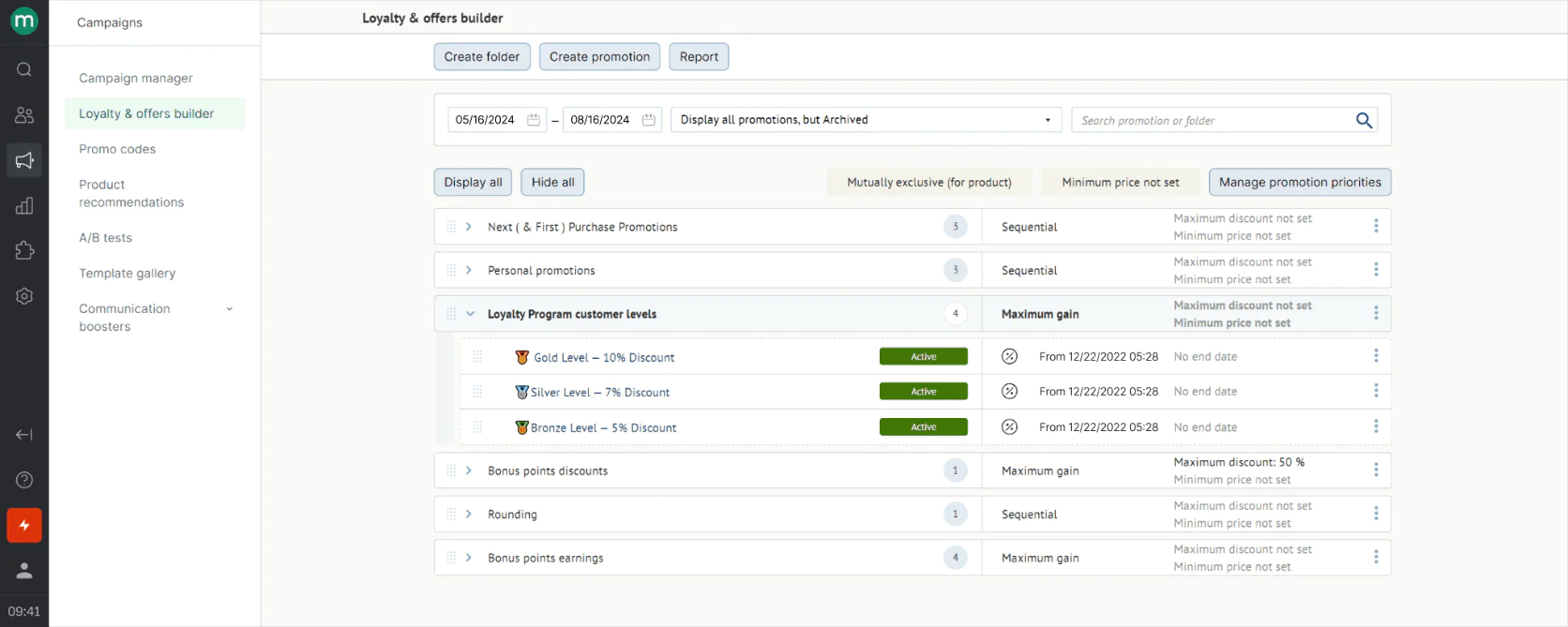
Maestra’s promotions rule engine
The advantages are significant: no need for third-party loyalty integrations (saving cost and complexity), and the marketing automation can leverage loyalty data effortlessly. Some concrete benefits:
- Real-time loyalty triggers: Maestra can trigger flows when customers earn or redeem points. E.g., send an SMS “You just earned 50 points!” right after purchase, or email a reminder “Your points are expiring” without delays.
- On-site loyalty widgets: Maestra provides widgets to display point balances or referral links on your storefront.
- Referral management: You can run refer-a-friend campaigns from the same platform, awarding points or coupons for successful referrals.
In essence, Maestra is best suited for companies that consider their loyalty program a core part of customer engagement. It not only eliminates the cost of a separate loyalty platform (which can be hundreds per month itself), but also drives higher customer retention due to more cohesive messaging. For Klaviyo or Omnisend users, achieving something similar requires stitching together multiple platforms (which is doable, just not as seamless).
Loyalty Programs Winner: Maestra
If you need robust loyalty program functionality natively, Maestra is the clear winner. Neither Klaviyo nor Omnisend offer native loyalty tools—they assume you’ll integrate those separately. Maestra’s loyalty features (points, rewards, referrals, VIP tiers) are fully built-in and tightly integrated with its messaging. This can be game-changing for customer retention marketing.
Klaviyo vs Omnisend vs Maestra: Ad Integration & Optimization
While email/SMS are owned channels, integration with paid advertising (like Facebook and Google ads) is key for an omnichannel strategy. Here we compare how each platform helps with ad optimization and audience targeting:
Klaviyo: ⭐⭐⭐⭐⭐
Klaviyo has strong integrations with Facebook (Meta) and Google Ads to use your customer data for ad targeting. Specifically, Klaviyo can automatically sync segments to Facebook Custom Audiences and Google Ads Customer Match. This means if you build a segment in Klaviyo, say “Customers—No Purchases in 6+ months”, Klaviyo can push that list to Facebook as an audience for you to run win-back ads, and keep it updated as people purchase or join that segment.
Similarly, you can exclude certain segments (like recent purchasers) from your ad campaigns to save budget. This is very useful for ad optimization, as it ensures your ads target the right people and don’t waste impressions on those already engaged via other channels. Klaviyo’s real-time updating here is a plus—the moment someone buys and moves out of a segment, they can be removed from the Facebook audience (with some latency of maybe an hour or so).
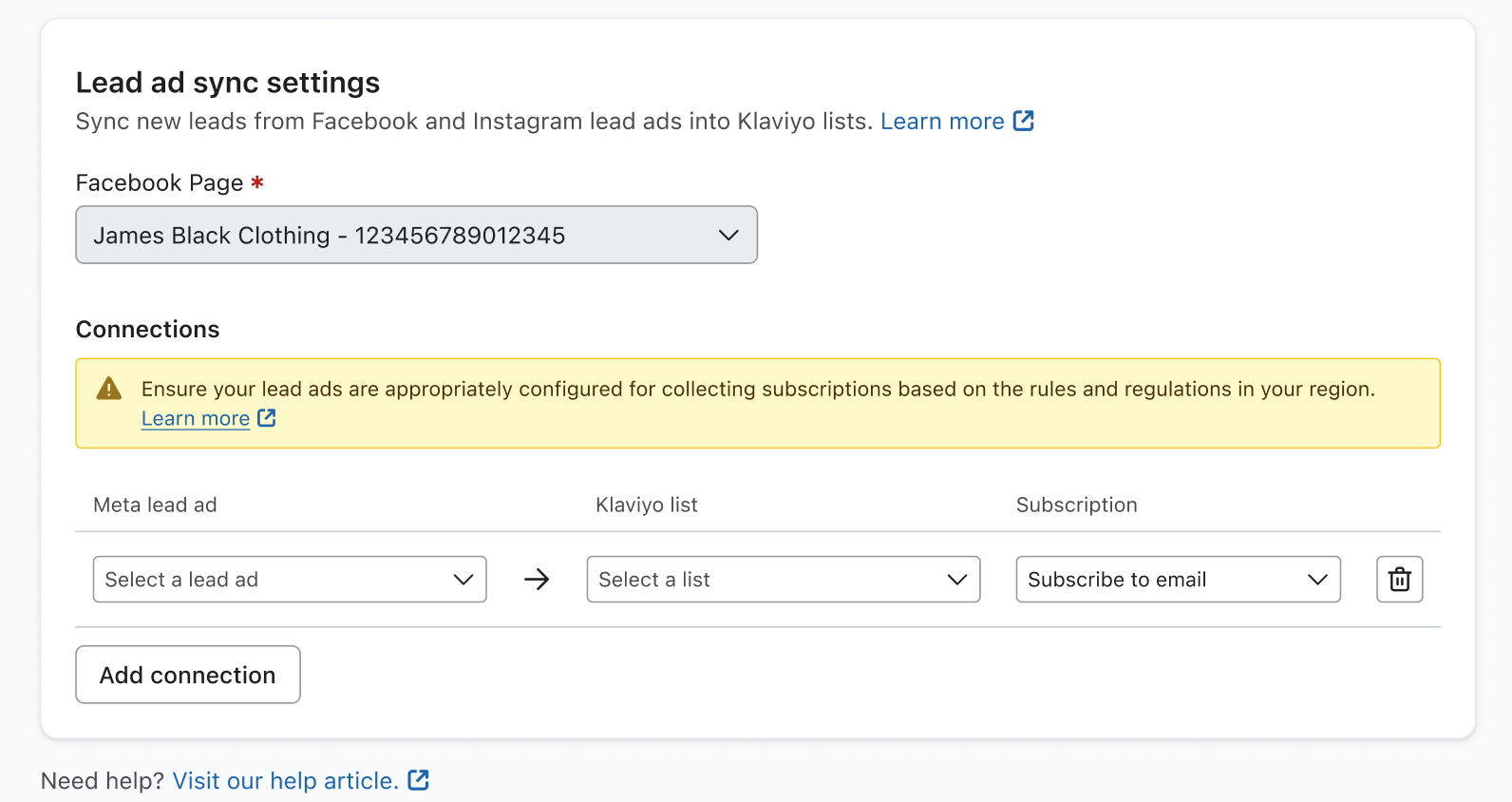
Klaviyo lead ad sync
Klaviyo also provides some analytics on how these ads perform (it can track if someone in a synced audience makes a purchase, attributing it to the “advertising” channel in reports). So you get a fuller picture of ROI.
Additionally, since Klaviyo is now partly owned by Shopify (which also has an ads product) and integrated with many platforms, it’s likely to keep enhancing ad targeting features. Already, many brands use Klaviyo segments to power lookalike audiences on Facebook (e.g., take your “VIP customers” segment from Klaviyo and create a lookalike—often yielding better prospective targeting than broad parameters).
Omnisend: ⭐⭐⭐⭐⭐
Omnisend similarly introduced Facebook Custom Audience sync feature. From Omnisend, you can create audiences on Facebook and have your contacts flow into them based on segments or workflow triggers. This allows retargeting (for instance, if someone subscribes via Omnisend form but hasn’t bought yet, add them to a Facebook ad audience for nurturing).
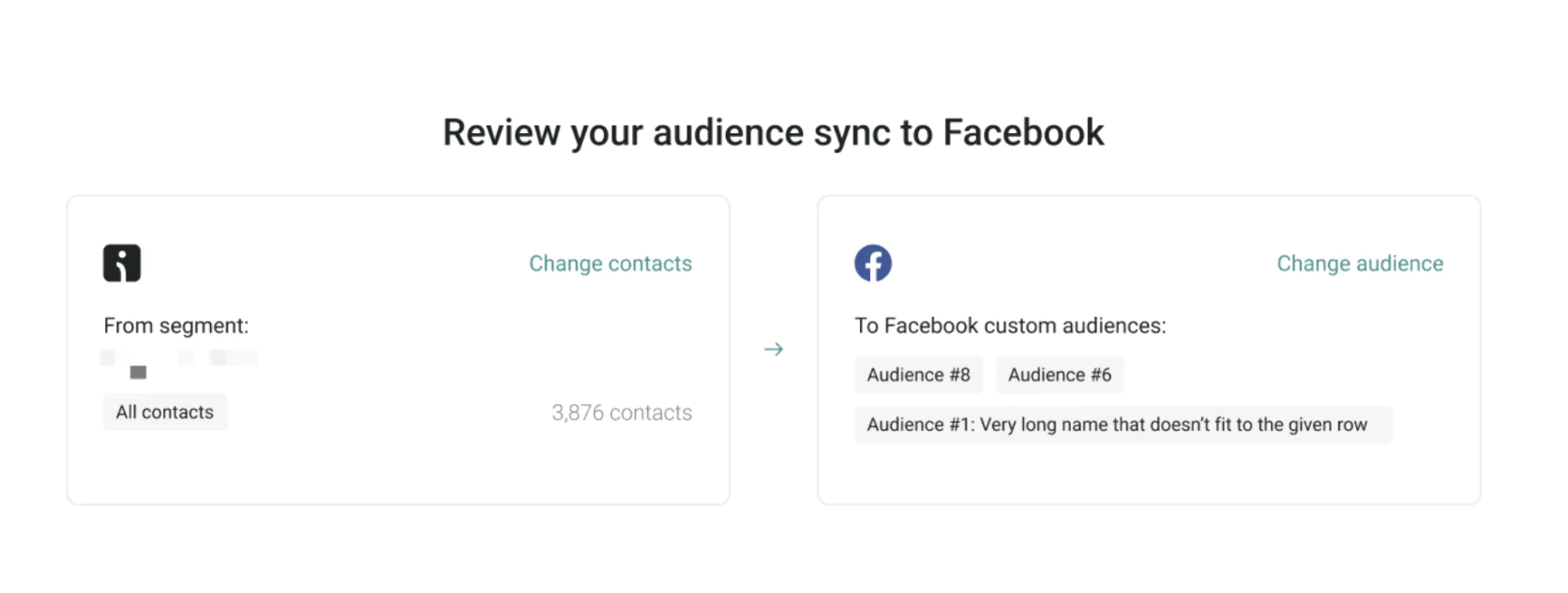
Omnisend’s Facebook Custom Audience sync
A unique thing: Omnisend can incorporate marketing channel performance in one place, but direct ad spend optimization (like adjusting bids) is not done in Omnisend—you still use the ad platforms for that. Omnisend’s value is feeding the right data into those platforms.
Maestra: ⭐⭐⭐⭐⭐
Maestra syncs audiences to ad platforms. Because Maestra aggregates all customer interactions, it can identify segments like “high lifetime value customers” or “never purchased” and sync those to ads similar to Klaviyo. Maestra enabled smarter targeting and suppression of wasteful spend (like not advertising to people who already converted via email, etc.).
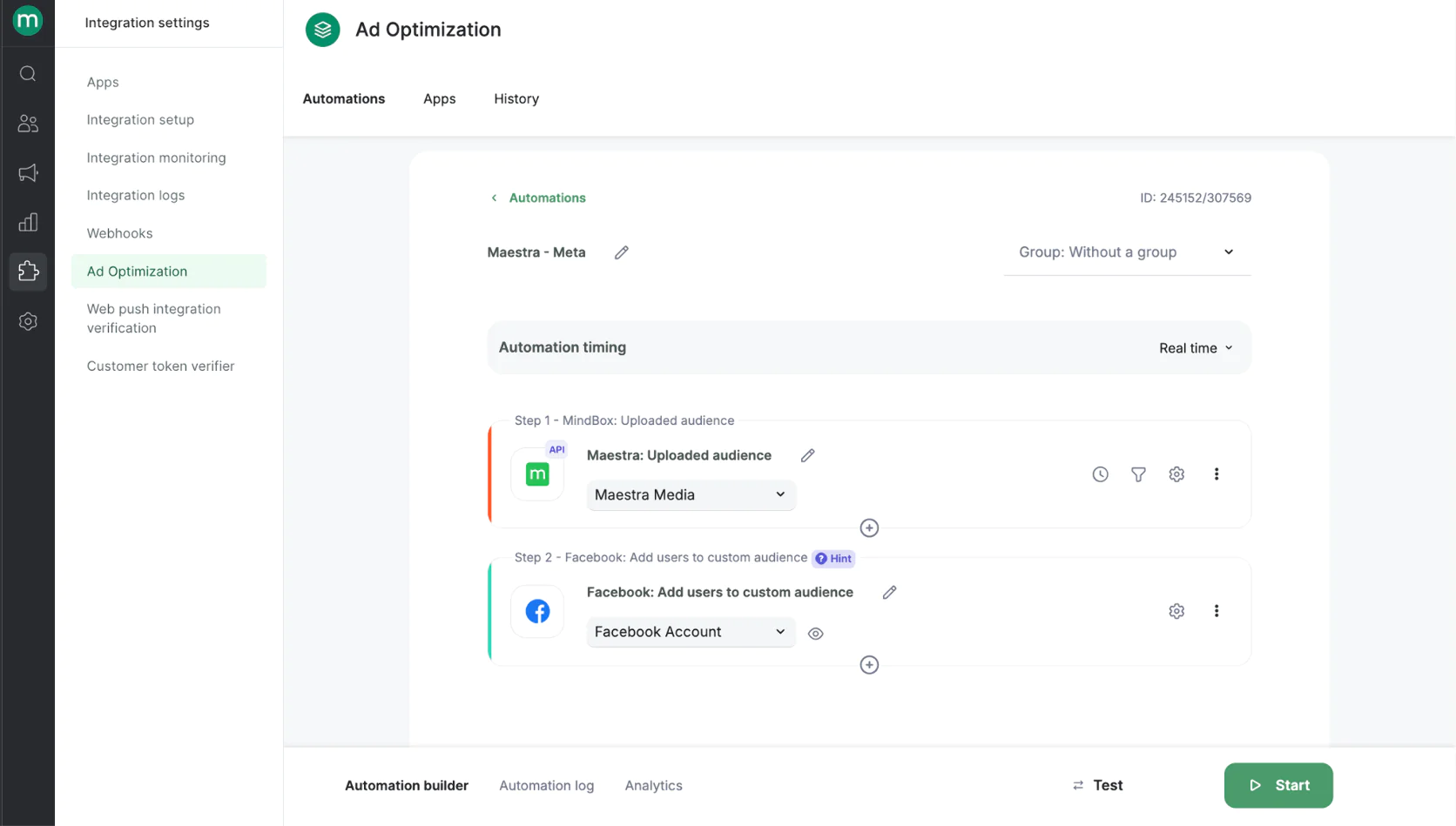
Maestra’s ad optimization
Maestra goes beyond audience syncing to orchestrate ads with other channels (like showing ads to customer who never opens emails).
Furthermore, because Maestra is real-time, it can remove buyers from ad audiences faster or include new high-intent visitors into retargeting audiences faster than daily syncs, which over time optimizes spend.
Ad Optimization: No Clear Winner
All three platforms recognize the synergy between owned marketing (email/SMS) and paid ads:
- Klaviyo gives robust audience syncing and has proven results with companies leveraging it for more efficient retargeting.
- Omnisend also offers this, keeping smaller brands from needing a separate tool to sync contacts to Facebook.
- Maestra takes it further by treating ad channels as part of the unified journey.
If you want your marketing platform to double as an intelligent audience source for ads, all will do, but Maestra’s paid media optimization suggests a more proactive role in improving ad spend ROI beyond just list syncing.
Klaviyo vs Omnisend vs Maestra: Analytics and Reporting
Data-driven marketing requires good analytics. Let’s compare the reporting capabilities of each platform:
Klaviyo: ⭐⭐⭐⭐
Klaviyo offers comprehensive analytics dashboards for your campaigns, flows, and overall customer metrics. For every email campaign, Klaviyo reports opens, clicks, unsubscribes, and crucially direct attribution like placed order count and revenue from that campaign (using its tracking snippet).
For flows (automations), it shows funnel metrics for each email/SMS in the sequence (how many got it, open/click rates, conversion rates). Klaviyo’s attribution model by default is relatively generous (if someone buys within X days of clicking an email, it credits that email), but you can adjust windows.
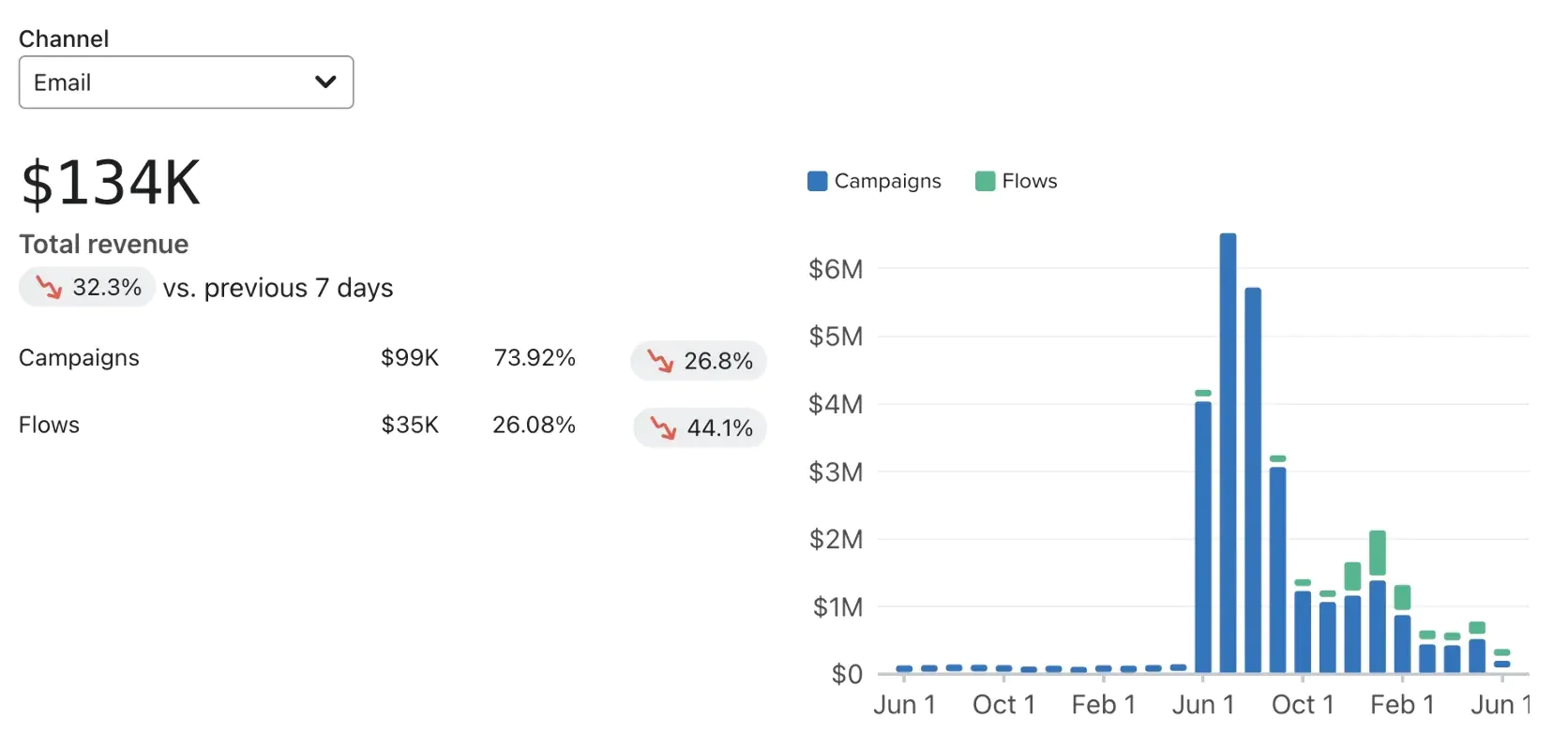
Fragment of Klaviyo’s business review dashboard
Klaviyo also has trend dashboards: you can see your total revenue over time and how much was attributed to Klaviyo (email/SMS) vs other sources. Cohort analysis is available (like tracking repeat purchase rate of customers acquired in a certain month). And with their predictive analytics, you get metrics like predicted CLV, churn risk, etc., which are more analytical.
They added Custom Reports which let you create reports on specific metrics or segments—useful if you want to, say, see “Revenue from repeat customers vs new customers month over month”—though this feature might be limited to higher plans.
Klaviyo’s analytics are often praised by eComm marketers because it ties directly to dollars. For example, you can tell your boss “Our email campaigns in Q4 drove $50k, and automated flows drove another $30k” with confidence, since Klaviyo tracks that. It also benchmarks your email performance vs industry peers (if you opt in) to see if your open/click rates are above or below average.
Omnisend: ⭐⭐⭐⭐
Omnisend provides a solid set of reports as well. On a per-campaign basis, it shows the usual email metrics and sales generated (Omnisend calls it “sales” from the campaign). They highlight features like campaign boost indicators, showing which campaigns performed exceptionally well.
For automation, Omnisend’s reports show how each workflow contributes to revenue (e.g., your abandoned cart series recovered $X this month—helpful for proving ROI).
One interesting analytic in Omnisend is the Marketing Performance Dashboard, which aggregates data across email, SMS, and push, giving you a combined view of your marketing outcomes. This omnichannel view can show, for instance, total orders and revenue influenced by Omnisend across all channels, which is great for understanding the tool’s overall impact.
In comparisons, some find Omnisend’s analytics a bit simpler or less granular than Klaviyo’s. For instance, Klaviyo might allow more fine segmentation in reports, whereas Omnisend might have canned reports. However, Omnisend does cover all essential metrics and even includes click maps for emails (to see which parts of an email got clicks).
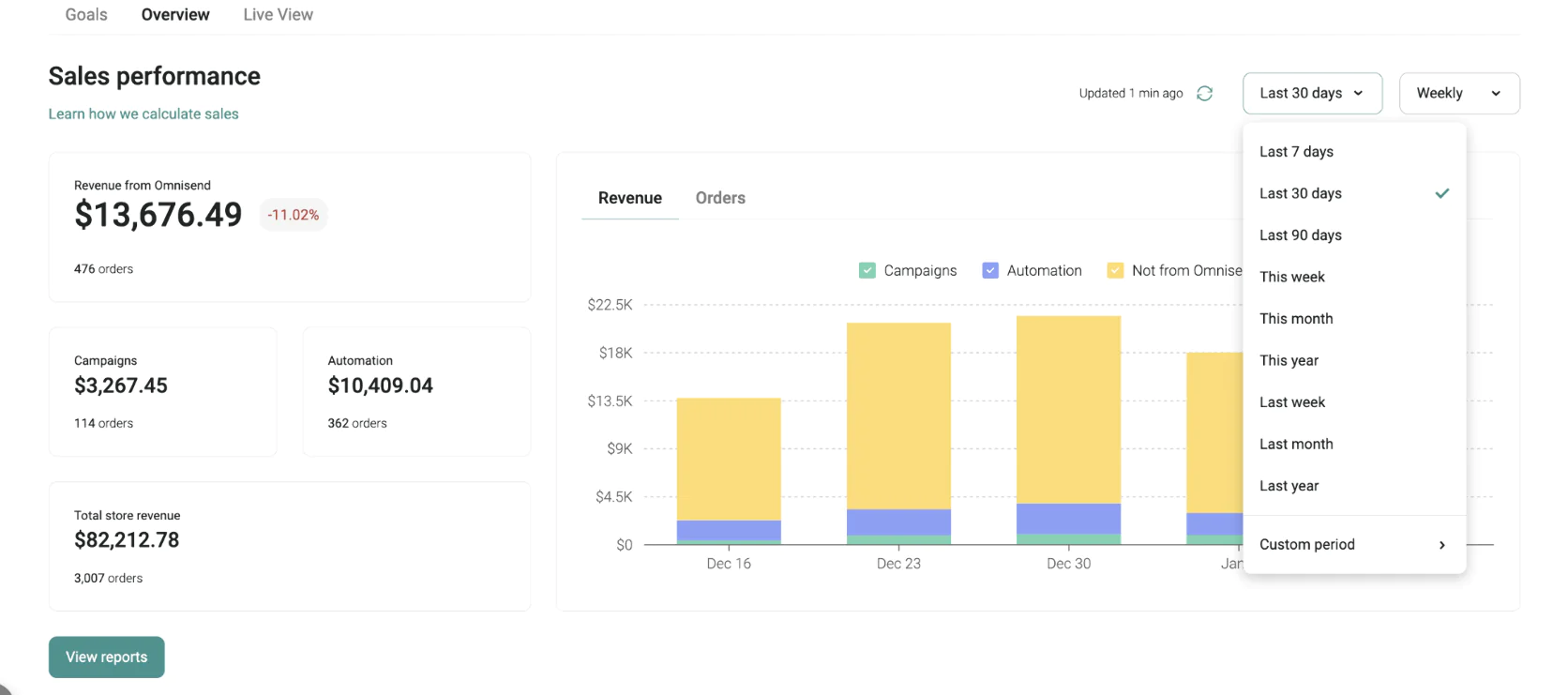
Omnisend’s Sales Performance dashboard
One notable feature: Omnisend’s reporting on subscriber growth — you can track how your list is growing, which forms are contributing, etc. And since Omnisend now includes product reviews, they may add metrics around review generation as well.
Overall, Omnisend’s analytics are user-friendly and visually clear, though perhaps lacking some advanced filters that a data-nerd might want. But for a marketing manager, they provide quick insight into “what’s working and what’s not” on the platform.
Maestra: ⭐⭐⭐⭐⭐
Maestra’s reporting goes beyond email/SMS to give a holistic picture. Maestra can attribute revenue to every channel (email, SMS, push, loyalty) since it orchestrates them. You might see, for example, how a multi-channel flow contributed to conversions at each step. Real-time reporting can show live campaign results as they happen.
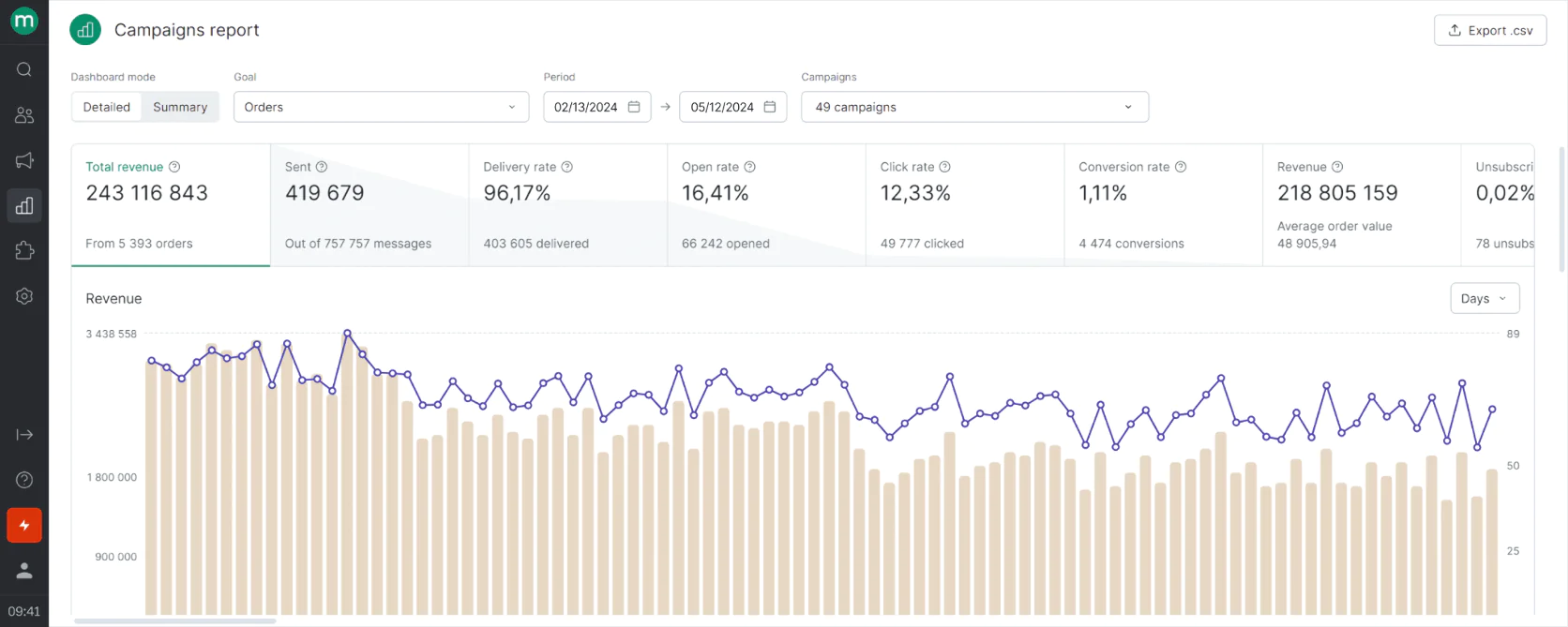
Maestra’s Campaigns report
Because Maestra functions as a CDP, it can do more advanced customer analytics: LTV analysis and segment-wise performance.
Another aspect is A/B test reporting. All three allow A/B tests (subject lines, different send times, etc.) and report which variant won. Maestra has robust test analytics.
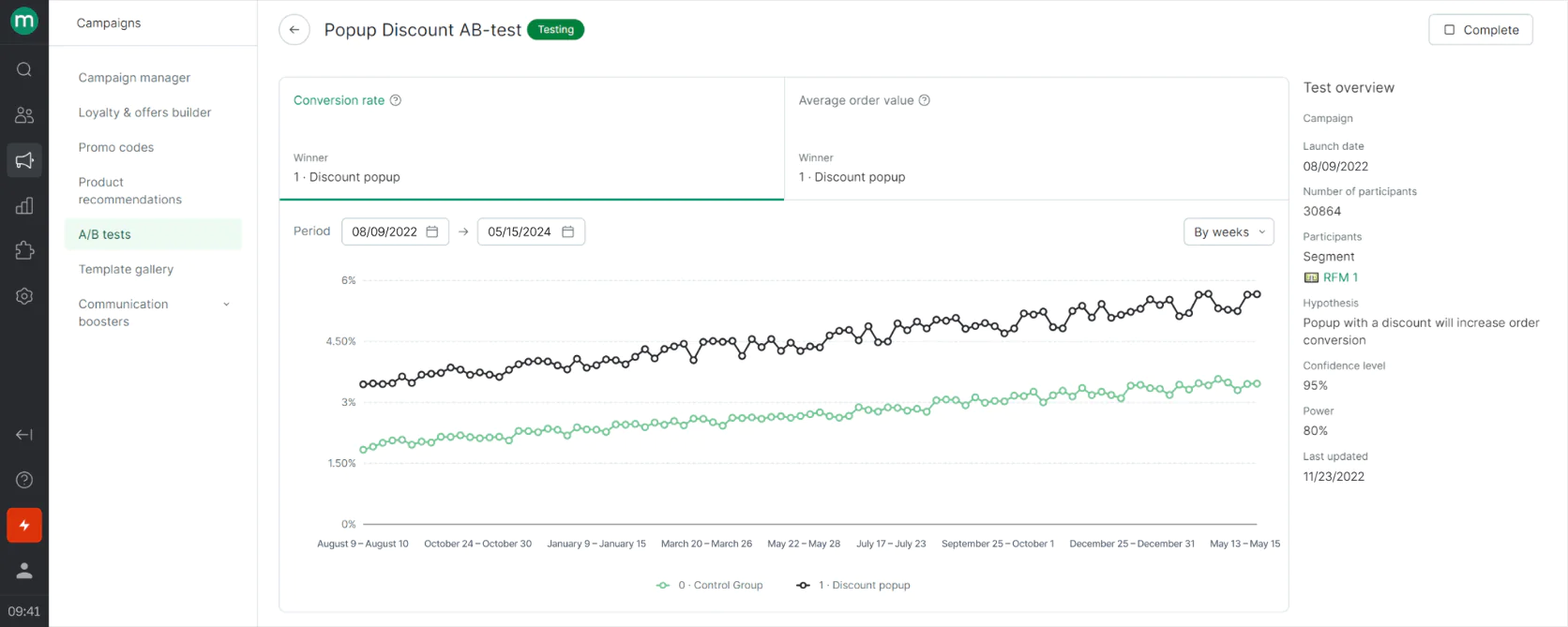
Maestra’s A/B test reporting
For loyalty, Maestra reports on loyalty program engagement: number of reward redemptions, points issued vs redeemed, effect on purchase frequency, etc., which the others wouldn’t since they don’t have loyalty built-in.
If we recall the earlier snippet: a brand using Maestra saw significant cost savings and engagement improvements—Maestra surfaced those insights via reporting.
Reporting and Attribution Winner: Maestra
Maestra is top-tier in analytics for data-driven eCommerce:
- Klaviyo has very detailed eCommerce-focused analytics and is slightly more mature in that regard than Omnisend.
- Omnisend covers all the key metrics in a digestible way and even aggregates multi-channel results, but might not dive as deep or allow as much custom analysis as Klaviyo.
- Maestra is built to be an insight engine, giving not just channel metrics but unified customer analytics.
If you need to justify marketing spend across channels and show how everything (ads, loyalty, email, SMS) is contributing to long-term customer value, Maestra’s comprehensive analytics will shine, as it can tie data together that other tools handle separately.
Klaviyo vs Omnisend vs Maestra: Customer Support and Services
No matter how good a platform is, solid customer support can make a huge difference, especially when you run into issues or need guidance:
Klaviyo: ⭐⭐⭐
Klaviyo’s support is somewhat infamous for being limited depending on your plan. All users get access to a robust Help Center and the Klaviyo Community Forum, which are great self-serve resources. However, direct support has some constraints:
- Email support: Free tier users only get email support for the first 60 days after signup. After that, free users rely on the community forum for help. Paid users have ongoing email support.
- Live chat: Available only to paying customers (any paid plan) and only during business hours. They don’t offer 24/7 chat; off-hours and weekend coverage is limited.
- Phone support: Klaviyo doesn’t offer phone support on standard plans. They do have premium support packages (at extra cost) for larger customers, which can include phone/consultations and faster SLAs.
Users have reported that Klaviyo’s email support can be slow (taking days to respond) during peak times. During critical moments (like Black Friday weekend), Klaviyo’s support hours have been criticized for not covering the full period.
The trade-off is Klaviyo provides a lot of documentation and training resources to help users be self-sufficient. For those on higher plans, Klaviyo offers a Customer Success Manager or onboarding specialists to assist with strategy and setup, but that’s typically for fairly large accounts.
In summary: Klaviyo’s support is knowledgeable but not always immediately accessible, especially if you’re small.
Omnisend: ⭐⭐⭐⭐⭐
Omnisend, on the other hand, is well-known for excellent support available to all tiers. They advertise 24/7 live chat support, even on the free plan. Many user reviews praise Omnisend’s support responsiveness — often getting a helpful reply in minutes via chat, regardless of the time. This is a big selling point, particularly for entrepreneurs who might be working on their store off-hours.
The average response time via chat is reportedly very quick (they claim under 5 minutes on average). In addition to reactive support, Omnisend provides onboarding for new customers (especially if coming from a competitor they have dedicated migration support deals).
They also have a decent knowledge base and academy content. So, Omnisend clearly wins in terms of support availability and responsiveness. They understand that smaller merchants may need more hand-holding and they deliver on that.
Maestra: ⭐⭐⭐⭐⭐
As a newer entrant targeting mid-market clients, Maestra offers more high-touch support. They assign a customer success manager to each client (given the higher price point and need to integrate various systems). CSM handles onboarding, data integration setup, initial flow creation, training, and strategic guidance. They’re available for direct contact whenever questions arise.
Support options include email, phone/Zoom planning sessions with your CSM, and chat for quick inquiries. Recognizing mid-market clients' expectations, Maestra prioritizes rapid response times and proactive assistance.
While Maestra maintains a knowledge base and documentation, they emphasize CSM guidance rather than self-service troubleshooting due to platform complexity.
For clients migrating from other platforms like Klaviyo, Maestra provides comprehensive migration assistance, including data transfer and recreation of key campaigns—a premium level of support typically available only through partners or on expensive plans elsewhere.
Customer Support Winner: Maestra
Maestra’s Customer Success Manager (functions as an extension of your team. Omnisend is known for accessibility and speed (ideal for SMBs who need quick answers at any time). Klaviyo has a vast knowledge base but more restricted direct support — fine if you’re self-sufficient, but can be frustrating in crunch times.
Klaviyo vs Omnisend vs Maestra: Pricing Comparison
Pricing can be a deciding factor, especially for budget-conscious businesses. Here’s a breakdown of how each platform approaches pricing and what to expect in terms of cost:
Klaviyo
Klaviyo operates on a subscription model based on the number of contacts (for email) and number of SMS messages (for SMS). They offer a Free tier for up to 250 contacts and 500 email sends per month (and 150 SMS/MMS credits). This free plan gives access to nearly all features (flows, forms, etc.), which is great for trying out the platform. Once you exceed 250 active contacts, you move into paid plans.
The paid plans scale as your list grows – for example, at 1,000 contacts, at 10,000, at 50,000, and so on, the monthly price increases.
As of 2025, the base price for email starts around $35/month for ~251-500 contacts, and scales up from there (e.g., ~$100/month for 5k contacts, $700/month for 50k contacts, etc. — exact brackets can be found on Klaviyo’s pricing page). SMS is charged separately (either you pre-pay for credits or pay as you go per message). Combining email + SMS can get pricey because you’re effectively adding two bills (though Klaviyo has a calculator to show combined cost).
Klaviyo is often considered premium-priced compared to some competitors. They did a pricing increase in Feb 2025, meaning some plans got more expensive. The justification is the value from their advanced features, but for a large list, Klaviyo can indeed become one of your bigger SaaS expenses.
So, small brands can start free on Klaviyo, but as they grow, they need to budget for potentially hundreds or thousands per month.
Omnisend
Omnisend also uses a contact-count based pricing, but it’s generally more affordable at equivalent list sizes and includes more in lower tiers. Importantly, Omnisend has a Free plan that lets you send up to 500 emails per month to up to 250 contacts (same threshold as Klaviyo’s free), AND that includes 500 web push messages and 60 SMS (the SMS on free is a nice touch). Essentially, Omnisend’s free plan is very comparable to Klaviyo’s but arguably a bit more generous with multi-channel (you can test SMS and push too).
Paid plans for Omnisend start at $16/month for 500 contacts (or up to 6,000 emails), which is lower than Klaviyo’s ~$35 at that level. As you scale, Omnisend remains cheaper per contact than Klaviyo.
Omnisend also includes all features (forms, automation, etc.) even in the Standard plan; the higher Pro plan mainly adds priority support (but since standard already has 24/7 chat, it’s more about service level guarantees).
SMS in Omnisend is pay-as-you-go; it’s not bundled in the plan price but you buy credits (their SMS rates are fairly standard, and you get some free credits each month on paid plans).
Overall, Omnisend is positioned as the more cost-effective solution for small to mid-sized businesses. Many comparisons note that Omnisend is more affordable and ideal for smaller stores. If budget is tight, Omnisend gives a lot of bang for the buck.
Maestra
Maestra uses a usage-based pricing model, it’s in the range of $2,000 to $+6,000 per month depending on the scale. There’s no free trial or free version; you schedule a demo and get a custom quote.
This price point reflects that Maestra is an enterprise/mid-market tool — it’s not intended for small businesses. The idea is that a midsize retailer might be paying separately for an ESP, an SMS platform, a loyalty platform, maybe a CDP or personalization tool, and possibly an agency — Maestra bundles a lot of that, so they price it accordingly as a premium but potentially cost-saving solution if you replace multiple tools.
Maestra’s ROI has to justify its cost. For a brand doing several million in revenue, spending $50k+ a year on a platform that drives, say, 20% of revenue (which is common for good CRM marketing) can be a good investment. But it’s clearly beyond the reach of a new or small store.
Key Takeaway
If you’re a smaller eCommerce business or very cost-conscious, Omnisend’s pricing is easier to stomach and you can unlock multi-channel marketing for a modest fee. Klaviyo is an investment that often pays off if you fully utilize it, but you need to be prepared for the cost scaling up as your list grows.
Maestra is for those in a different league—you’d consider it when you’re ready to invest a few thousand a month to potentially replace 3-5 other tools and centralize your marketing.
Klaviyo vs Omnisend vs Maestra: Ideal User Base (“Best For”)
Each platform tends to fit best for certain types of users or businesses. Here we summarize the ideal user base for Klaviyo, Omnisend, and Maestra:
Klaviyo—Best for SMB and Mid-Market Ecommerce Focused on Growth
Klaviyo is best for small to mid-sized eCommerce brands (including Shopify stores) that are looking to aggressively grow and are willing to invest in data-driven marketing. If you:
- Operate an online store (from startup stage up to tens of millions in revenue)
- Want advanced email and SMS automation to maximize customer LTV
- Have the resources to create targeted campaigns and analyze data
- And perhaps are an experienced marketer or have a team
then Klaviyo is a top choice.
It’s especially popular among Shopify users. Brands that have outgrown basic email tools (like Mailchimp) often move to Klaviyo to get more sophisticated segmentation and automation.
However, very small businesses on a shoestring budget might find Klaviyo’s cost tough once they pass the free threshold. And non-eCommerce businesses (like content sites or B2B services) might not get as much value from Klaviyo’s eComm-centric features.
In short: Klaviyo is best for serious eCommerce marketers who want a powerful, proven platform and are comfortable with a bit of complexity to unlock value. These users typically have a mindset of “customer segmentation, analytics, and optimization” as key to growth.
Omnisend – Best for Small E-commerce and Beginners in Multichannel Marketing
Omnisend is ideal for smaller online stores, independent brands, and lean marketing teams who need an easy-to-use, cost-effective platform to cover email, SMS, and push in one place. If you:
- Are relatively new to email marketing automation or don’t have a dedicated email specialist
- Have a limited budget but want to utilize multiple channels (email, SMS, push) to engage customers
- Prefer a simpler interface with preset workflows and templates to save time
- Or are migrating from a basic service (like Mailchimp) and want more eCommerce-focused features without a steep learning curve
Omnisend is a great fit.
It’s often recommended for beginner to intermediate email marketers and for stores that are just starting to build out automation. The platform’s guidance (pre-built automation, step-by-step wizards) and responsive support make it approachable.
Industries: Mostly online retail—fashion, accessories, niche products, etc. Many Shopify and WooCommerce users who find Klaviyo too pricey or complex choose Omnisend as a balance of functionality and affordability.
It’s also good for those who want all-in-one light—Omnisend covers multiple channels so you don’t need separate SMS or pop-up tools, which is appealing if you want to minimize tech overhead.
Large enterprises likely wouldn’t use Omnisend as it’s not as advanced in data or scaling to millions of contacts. But for the vast majority of small-mid stores (say from 0 to a few million in revenue, or up to 100k-200k contacts), Omnisend can handle their needs with ease and at lower cost.
In short: Omnisend is best for small to medium eCommerce businesses and marketing teams that want an intuitive, affordable omnichannel marketing solution.
Maestra—Best for Midsize Retail Brands Seeking an All-in-One, Data-Intensive Solution
Maestra is tailored for mid-sized and enterprise retail brands (including those with both online and offline presence) that want to unify their marketing, loyalty, and data management into a single powerful platform. You might be a good fit for Maestra if:
- You are a retail brand with significant customer data from multiple channels (eCommerce site, one or more physical stores, mobile app, etc.) and you need to consolidate that data
- You have or want to launch a loyalty/rewards program and prefer it integrated with your marketing communications
- You have a dedicated marketing team (and possibly data analysts) who will utilize advanced segmentation, personalization, and maybe even custom metrics
- Your business is at a scale where using 3-5 different tools (ESP, SMS, loyalty app, CDP, etc.) is getting unwieldy or expensive, and you’re ready to invest in a unified solution
- You require real-time marketing actions (e.g., trigger offers on the fly as customers shop, very timely messaging) that typical systems can’t handle as quickly
Maestra is best for mid-market DTC and retail brands doing tens of millions in revenue and up, who want an enterprise-grade solution without going to a legacy enterprise software. For example, a regional retail chain with an online store and loyalty club, or a fast-growing DTC brand with more than 100,000 customers might look at Maestra to scale their retention marketing.
These users often have outgrown platforms like Klaviyo in some areas (like they need more robust loyalty integration or faster data sync or multi-store support). They also typically have a budget and team to handle a complex tool.
In short: Maestra is best for larger, data-centric eCommerce or omni-channel retailers who want a one-stop platform for marketing automation, loyalty, and customer data platform capabilities. It’s for those who view personalized, real-time customer engagement as a strategic priority and are willing to invest accordingly.
If you’re a midsize retail brand aiming to emulate enterprise-level customer marketing (without stitching many tools), Maestra is a prime candidate—book a demo with the Maestra team.
Klaviyo vs Omnisend vs Maestra: Final Verdict
Choosing between Klaviyo, Omnisend, and Maestra ultimately comes down to your business’s needs and growth stage. All three are capable platforms, but they serve different niches:
- Klaviyo excels in advanced email & SMS marketing for eCommerce, with powerful segmentation and proven ROI for growing brands. It’s a trusted choice if you want to leverage data to the fullest and are prepared for the investment. Thousands of Shopify stores rely on Klaviyo to drive revenue through tailored campaigns and flows.
- Omnisend offers a balanced, cost-effective omnichannel solution. It brings email, SMS, and web push together with an easy learning curve—perfect for newer or smaller shops that want to engage customers on multiple channels without complexity. Omnisend’s generous free plan and stellar support lower the barrier to marketing automation.
- Maestra represents the next-generation all-in-one marketing platform for those who need more than just email and SMS—integrating loyalty, deep personalization, and real-time data. For midsize retail brands aiming for a unified customer journey across channels, Maestra can be transformative (replacing disparate systems with one cohesive platform). The trade-off is cost and complexity, which are justified by equally big opportunities in customer lifetime value and efficiency gains.
In summary, consider your scale and strategy:
- Choose Klaviyo if you need a proven powerhouse for email/SMS and you’re focused on maximizing eCommerce metrics with sophisticated campaigns.
- Choose Omnisend if you favor ease of use, budget-friendliness, and quick implementation of omnichannel basics to incrementally grow your sales.
- Choose Maestra if you are ready for an integrated approach that not only markets to customers but also builds loyalty and leverages every byte of customer data in real time to personalize experiences, online and offline.
By aligning the platform’s strengths with your marketing objectives, you’ll set the stage for successful customer engagement and revenue growth. Each of these tools can drive excellent results when used to its potential, so it’s about finding the best fit for your brand’s size, resources, and vision for customer experience.
Ready to boost your e-commerce marketing? Book a demo with Maestra team. We’ll show how Maestra can accelerate your growth.
